|
|

Linking Life Zones, Life History
Traits, Ecology, and Spatial Cognition
in Four Allopatric Southwestern Seed Caching Corvids
|
Abstract
This report will review the similarities and differences of
four species of pine seed caching members of the avian
family Corvidae that live on the slopes and base of the San
Francisco Peaks in north-central Arizona. The four species
include the Clark’s nutcracker (Nucifraga columbiana),
pinyon jay (Gymnorhinus cyanocephalus), western
scrub-jay (Aphelocoma californica), and Mexican jay (A.
ultramarina). These corvids demonstrate a specialization
gradient for the harvesting, transporting, caching and
recovering of buried pine seeds. This gradient is reflected
in their dependence on cached pine seeds for winter and
early spring survival and reproduction. Species most
dependent on these cached seeds have the greatest number of
adaptations for utilizing these seeds which is especially
evident in their spatial memory abilities to locate their
caches. The two most dependent species, nutcrackers and
pinyon jays have spatial memory abilities more accurate than
in the species less dependent on cached seeds, western
scrub-jays and Mexican jays. Using converging operations to
test these memory abilities, comparative tests were
conducted in an open field cache/recovery experiment, an
analogue radial maze test and operant tests of spatial and
non-spatial memory. Also discussed are the techniques used
by nutcrackers to recognize and relocate caching sites.
These birds have the ability to learn and generalize
geometric rules about the placement of landmarks. This
geometry, especially using multiple landmarks, aids this
species greatly. The use of the sun compass by pinyon jays,
scrub jays and nutcrackers reveal that in experimental
conditions where birds are clock-shifted they respond to
this shift, thus digging for caches in locations predicted by
the shift. It appears that pinyon jays are converging on a
distant relative the nutcracker in many characteristics,
thus diverging from their close relatives the western
scrub-jay and Mexican jay. Each species has a suite of
adaptive traits that reflects its natural history and life
history.
|
|
Chapter Outline and Navigation
|

|
Figure 1. C. H. Merriam (white shirt)
|
Temperate and alpine
regions experience large climatic shifts between summer and
winter. To survive, animals must deal with these seasonal
changes. Tactics used to address with these changing
conditions include migration, hibernation, laying
over-wintering eggs, or living off the land (finding food
and shelter under changing conditions). Animals that live
off the land are referred to as permanent residents. Often
these animals have to change the amount and types of foods
they eat to accommodate the energetic and nutritional
demands imposed by the physiological needs of the different
seasons of the year. For example, most permanent
resident birds eat insects and arachnids during the summer
when these food types are abundant, and seeds, berries, and
over-wintering eggs and larvae, during the winter when these
food items may be abundant. Some birds, however, do
something quite different. They prepare for the
upcoming winter by provisioning food in the late summer and
autumn and then recover and consume it during the harsh
winter season, days, weeks, or even months after the items were
initially stored. In this chapter we will define the
ecological conditions under which these behaviors occur and
the suite of adaptive behaviors used by the birds in their
quest for survival and reproduction.
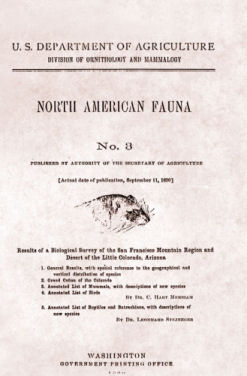 |
Figure 2. Cover of North American .Fauna No. 3.
|
Food-storing adaptations have been observed in many avian taxa, including
woodpeckers, nuthatches, chickadees and tits (see Vander Wall, 1990 for review
of this topic). In this chapter, we will concentrate on a group of seed caching
birds of the family Corvidae, the Clark's nutcracker (Nucifraga
columbiana), pinyon jay (Gymnorhinus cyanocephalus), Western
scrub jay (Aphelocoma californica) and Mexican jay
(Aphelocoma ultramarine). These birds co-exist in a relatively
small area of north-central Arizona, the San Francisco Peaks.
These peaks are geographically compact and isolated from other mountainous
areas, thus providing an unusual natural laboratory to study food-storing,
particularly for describing similarities and differences among the four
species. In the first part of this chapter, we describe the
habitats occupied and utilized by the seed caching corvids. In
succeeding sections, we use this background information to illustrate the how
and why these conditions, acting as selective forces, have affected the
behavioral patterns of these birds.
The San Francisco
Peaks were made famous in the 1880's when they were studied
by C. Hart Merriam, an early ecologist and the first
Director of the present U.S. Fish and Wildlife Service
(Figure 1). He described the distribution of plants
and animals along an elevational gradient on the sides of the Peaks and compared
this distribution to the latitudinal distribution of plants and
animals from temperature to artic regions of the eastern U.S. He
published a famous monograph on this topic in 1889 (Figure
2). Bands of like plants and animals that had the same elevational
distribution were referred to as life zones (Figure
3B).
Because the mountain is rather simple, both geologically and
geographically, the zones were relatively easy to identify and
describe. It was possible to visit all the life zones on the
Peaks in half a day. This made it easy to record the similarities
and differences in the behaviors of the birds of interest. A brief description
of the life zones on the San Francisco Peaks, beginning with the
highest elevations and moving downward, will set the stage for
understanding the ecological reasons that these seed caching birds
behave as they do.
 |
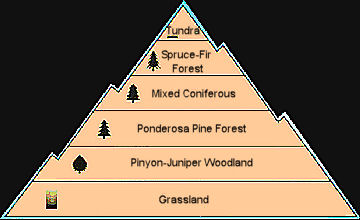
|
Figure 3A. San Francisco Peaks.
|
Figure 3B. Life Zone Distribution on San Francisco
Peaks.
|
1. Alpine Tundra. (Figure 4)
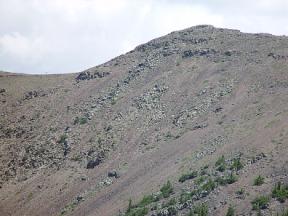
|
Figure 4. Alpine Tundra.
|
This zone exists on the very top of the Peaks, 3,865 m
(12,670 ft). Vegetation at this elevation is sparse. This area is
above tree line and supports only two small species of
shrubs.
At tree line there are snall gnarled patches of Engelmann spruce (Picea
engelmannii) and bristlecone pine (Pinus aristata). In
winter, the tundra zone is subjected to strong winds, low temperatures and
heavy snow that may be present in protected pockets well into summer. Summer
rains can be torrential. The growing season is short as freezing
temperatures can occur in May and August. The single seed caching corvid that
regularly visits this zone is the Clark's nutcracker and it does so in late
summer and early fall before the snow flies. Here it can be found with its
offspring of the year, foraging, digging in the soil, catching insects, and
caching seeds of bristle cone pine, limber pine (Pinus flexilis),
and southwestern white pine (Pinus strobiformes) that are carried
upward by the adults as the seeds mature at lower elevations in late summer and
early fall. All or most of this activity by nutcrackers ceases once the zone is
covered with snow. Thus, these cached seeds are not recovered until the area is
free of snow the next spring and summer, some 8-10 months later.
2. Spruce-fir Forest. (Figure 5)
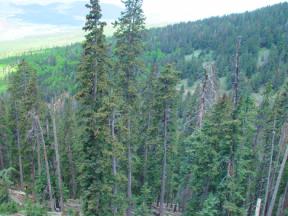 |
Figure 5. Spruce-Fir Forest.
|
This zone of
dense coniferous trees consisting of Engelmann spruce,
alpine fir (Abies lasiocarpus), limber pine, and bristle cone pine
exists directly below the tundra at elevations from about 2,745 m (9,000 ft.)
to 3,660 m (12,000 ft). Forests can be dense with a continuous layer of
canopy cover so thick that few under story plants can thrive in
this extreme shade. A thick layer of litter and duff
covers the ground in most areas. Grassy alpine meadows are interspersed with tree covered areas.
This zone is characterized by high winds, heavy snow fall in winter and rain
fall in summer, cold winter temperatures and cool summer temperatures. Clark's
nutcrackers and Steller's jays (Cyanocitta stelleri) are common
inhabitants of this zone. Both nest here, extract seeds from the cones of both
species of pine, and readily cache seeds here. (Although Steller's jays are
industrious cachers we have studied them little because they do not do well in
captivity.) Occasionally in late summer and early fall flocks of pinyon jays
can be seen and heard traveling through the area. Presumably, these birds are
searching for pine seeds.
3. Mixed Coniferous Forest. (Figure 6)
 |
Figure 6. Mixed Coniferous Forest.
|
This zone exists
at elevations between 2,287 m (7,500 ft) and 2,745 m (9,000
ft). The principal trees are firs, primarily Douglas fir
(Pseudotsuga menziesi) with occasional white firs (Abies
concolor) and ponderosa pines (Pinus ponderosa) found on
warmer
exposures. Here, two closely related species of pine intergrade, the
southwestern white pine (Pinus strobiformis) and the limber pine
(Pinus flexilus), and form large stands on the side of the
Peaks. A deciduous tree, Gambel oak (Quercus gambeli) is
present in low numbers. The canopy is complete so the forest floor is well
shaded and contains a thick mat of litter and duff. Alpine meadows and stands
of quaking aspen (Populus tremuloides) are interspersed among the
conifer stands. Winters are cold and windy, with heavy snows at times and
modest amounts of summer rains. Climatic conditions in this zone are more
moderate than in the above spruce-fir zone, but still rather harsh in
winter. Clark's nutcrackers and Steller's jays are the principal seed
caching corvids inhabiting this zone with occasional visitations by flocks of
pinyon jays.
4. Ponderosa Pine Forest. (Figure 7)
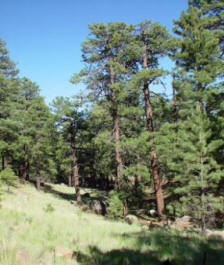 |
Figure 7. Ponderosa Pine Forest.
|
This zone is present from 2,105 m (6,900
ft) to 2,287 m (7,500 ft) .This forest is a monoculture, as the
dominant and predominant tree is ponderosa pine. In some areas Gambel oak may be
present at modest densities. Ponderosa pine forest form open stands of large trees, in contrast to
the above forests where the canopy is
complete. Pine nettles and cones from past years accumulate on the
forest floor and can form a thick mat of 5-10 cm. In some areas pine
trees are dense and small forming dog-hair thickets. Winters are
modest with snowfall amount below those experiences in the above
zones with summer rains also occurring in moderation. The growing
season extends from late April to early September.
In recent years
wild fires have commonly consumed large tracts of this forest. This
is the lowest elevational extension of the coniferous forest on the
peaks. Steller's Jays occur at maximum densities here and
readily caches the seeds of ponderosa pines. These jays also descend
to the upper reaches of the next lower zone to harvest and carry
pine seeds up into this forest. Flocks of pinyon jays roam through
portions of this forest, harvesting and caching ponderosa pine seeds
and, like the Steller's jay descending into the woodland to harvest
and carry seeds up into this zone. Pinyon jays commonly nest in this
forest. At the lower edges of this zone and on drier sites Western
scrub-jays and Mexican jays occur. They also harvest and cache
ponderosa pine and pinyon pine seeds here.
5. Pinyon-Juniper Woodland. (Figure 8)
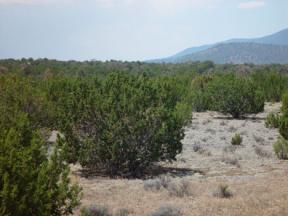
|
Figure 8. Pinyon-Juniper Woodland.
|
This extensive zone occupies the base of the mountain and lies
between 1,680 m (5,500 ft) and 2,135 m (7,000 ft). This zone
occupies the largest amount of area of all the zones because there
is more land mass at the lower elevation where these trees live.
The
predominant trees are Colorado pinyon (Pinus edulis)
and a host of junipers (Juniperus
osteosperma, J. monophylla, J. scopulorum, J. depppeana). The
upper elevations are dominated by pinyon pine and the lower
regions may consist solely of junipers. Because moisture is
limiting, trees are spread out with large openings between them. The
under story supports some shrubs, succulents and cacti. The
climate is mild in winter and hot in summer. Modest rains occur in
summer and winter moisture is in the form of both rain and snow.
Winter snows melt relatively quickly. Insects and arachnids and some
small mammals are active throughout the year. Populations of
western scrub jays and Mexican jays reached their highest levels
here. These jays harvest and cache pinyon pine seeds when available.
Also resident, are flocks of pinyon jays that use the pinyon pines
in great numbers. Steller's jays and Clark's nutcrackers descend the
mountain and collect large amounts of pine seeds that they then
carry up into their normal habitats. The pinyon pine is the most
heavily sought after pine on the San Francisco Peaks.
Some important ecological patterns
emerge along the Life Zone gradient. At the top of the mountain it
is cold in winter, with heavy snow, but cool in summer with heavy
rains, and frequent clouds that obscure the sun, especially in
winter and mid-summer. Plant and animal productivity is restricted
by a short growing season in late spring and summer. In the higher
coniferous forests, tree density is high and canopies are closed,
with a thick layer of decomposing plant parts on the ground. At
lower elevations, it is cool but mild in winter, with little snow,
but hot in summer, with sparse rains. Clouds are much less frequent
than at higher elevations. Plant and animal productivity is spread
out over a 9-10 month period and most animals remain active year
round due to the mild and hospitable climatic conditions. The pine
forest and woodland have an open canopy with sunlight reaching
ground level throughout. Almost no plant decomposition is occurring
on the woodland floor and bare ground is often exposed.
Consequently, each Life Zone has a
unique set of ecological properties and constraints that act as
selective forces shaping the adaptive traits of the creatures
inhabiting it. Because of the compactness of the mountain and the
compressed nature of these adaptive zones it was relatively easy to
observe the similarities and differences among the seed caching corvids. There is a general trend of increasing
numbers of seed caching corvids species with decreasing elevation
throughout the forest and woodland zones. For example, only
the nutcracker visits the alpine tundra, but all five species
(nutcracker, Steller's jay, pinyon jay, western scrub jay, and
Mexican jay) visit the pinyon-juniper woodland. In the high
coniferous forests the nutcracker and Steller's jay are resident
whereas in the low woodland three species of jays (pinyon jay,
Western scrub jay and Mexican jay) are resident. Only the
scrub jay apparently uses the grassland which occurs below
the woodland.
On the slopes of the San Francisco
peaks, four species of pines produce seeds that are
harvested, transported, cached and later recovered by the seed caching corvids.
In order of descending importance to the birds these are: pinyon pine,
limber/southwestern pine, ponderosa pine, and bristlecone pine. A brief
description of the characteristics of each that make them attractive to the
seed caching birds follows in order of descending elevational distribution.
1. Bristlecone pine.
This species is the rarest of the pines and exists at the highest elevations,
usually at or near tree line in the spruce-fir forest. The seeds are tiny,
ranging in size of between 10-13 mm (Schopmeyer, 1974) and contain a 10-13 mm
wing. The seeds are grey to brown to black. The cone, as the trees name
indicates, is armed with narrow, sharp, pointed needle-like spines to protect
the seeds from predators. The cone is oriented downward on the branch.
Bristlecone pine produces some cones most every year, and seeds readily fall
when they open. This pine relies mainly on wind to disperse its seeds, and
little is known about the harvest transport, caching and recovery of this
species by seed caching corvids, primarily Clark's nutcrackers and Steller's
jays. This pine is probably not a significant source of food for either of
these species.
2. Limber and southwestern white pine complex.
This species complex reaches its high densities in the mixed coniferous
forest with a few individuals extending upward in the spruce-fir forest and
down into the upper edge of the ponderosa pine forest. (On the San Francisco
Peaks these two species interbreed thus we refer to them here as ?a species
complex?) The wingless seeds are relatively small (10-15 mm in length) and
brown in color. The cone contains either weak spines or no spines at all.
Cones are oriented downward. This pine is prized by nutcrackers and Steller's
jays which work with great industry to harvest the seeds, which are cached
within this forest type and in nearby open meadows (Benkman et al., 1984).
Both Steller's jays and nutcrackers extract the seeds from open cones. Pinyon jays occasionally visit these trees in late autumn, harvest seeds and
carry them down hill into the ponderosa pine forest and pinyon-juniper
woodland where they are cached.
3. Ponderosa pine.
This species exists in almost pure stands below the mixed coniferous forest.
The tree produces some cones in almost every year and huge crops in some
years. The small seeds (3-4 mm in length) are attached to a wing that may be
five times as long as the seed (16 mm in length). The seed coat is brown with
occasional dark mottling. Cones contain many sharp, decurved spines for
protective armament. Cones are oriented downward on the end of branches and
seeds are readily released from ripe cones. All four jays (Steller's, pinyon,
scrub and Mexican) and Clark's nutcracker harvest,
transport, cache, and recover the seeds from this tree,
even though this species relies mainly on wind for the
dispersal of its seeds. Wings are broken off the seeds
before they are transported. Nutcrackers clip them off
with their bills while the jays use a branch or other
stationary object to smash the wing with a strong swipe
of the bill.
4. Colorado pinyon pine. (Figure 9)
 |
Figure 9. Pinyon pine tree.
|
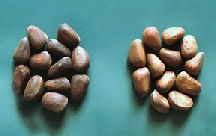 |
Figure 10. Yellow
seeds (right); dark brown seeds (left).
|
This species lives below the
ponderosa pine forest. Trees are spaced more openly than any
of the above. This species is the only masting species of
the conifers harvest by the birds. Usually a few cones are
produced on many trees every year but in extreme years no
cones are produced, or just the opposite, with most trees
producing thousands of cones per tree. When trees produce such a large crop of seeds this is known as a
"mast" crop. These extremes occur about once every seven years (Table 1).
Table 1. Qualitative Measures of Pine Cone Density
& Cache Intensity
|
1. No Cones (2 of 7 years)
|
No cones = No seeds = NO CACHING
|
2. Low Cone Crop (2 of 7 years)
|
Few cones = Few seeds = NO CACHING
|
3. Modest Cone Crop (2 of 7 years)
|
Modest cones = Modest seeds = CACHING
|
4. Heavy Cone Crop (1 of 7 years)
|
Many cones = Many seeds = INTENSE
CACHING
|
It has been suggested that masting
insures that the seed caching birds and other seed predators
are unable to harvest and consume all available seeds and
thus the predators are "swamped". They cannot build up
populations of sufficient numbers to totally decimate the
seed crop (Vander Wall, 1990; Vander Wall & Balda, 1977). This species places its cones near the end of branches,
where they are positioned to point outward or upward. Cones open
asynchronously on each tree and in different regions. Seeds are
relatively large (10-15 mm) and wingless and held in deep grooves on
the cone scale. The cone scales are relatively short and contain
flanges that act to hold the seeds in the cones so they are not
easily dislodged. The flange disintegrates after the first frost in
autumn and then the seeds fall out of the cone. Seed coat color
differs drastically between seeds that are full of female
gametophyte material (dark, chocolate brown) and those that
are empty (light yellow) (Figure 10).
All five seed caching corvids are
attracted to the cones of pinyon pine to
extract seeds. The Clark's
nutcracker and pinyon jay are able to open tightly closed green
cones, whereas the three other jays must wait for the cones to open
naturally. The scrub-jay may not recognize that the yellow hulled
seeds are empty (Vander Wall & Balda, 1981). This species of tree enjoys the widest elevational range of any pine on the San Francisco Peaks. Trees grow
from 1,680 m (5,500 ft) to over 3,600 m (11,000 ft). These higher
stands were most likely "planted" by nutcrackers, as we have seen
them transport seeds to these areas (Vander Wall & Balda, 1977).
When pine cones are present, the seed caching corvids expend considerable time
and energy harvesting, transporting, and caching pine seeds each autumn. Each
species shows different types of morphological, ecological and behavioral
specializations for this task. Here we describe these specializations for each
species.
1. Clark's nutcracker. (Figure 11)
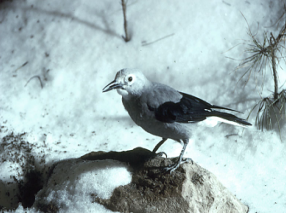 |
Figure 11. Clark's nutcracker in snow.
|
This species lives and nests at the
highest elevations on the San Francisco Peaks, of all the seed
caching corvids. They nests in spruce-fir, mixed conifer and
ponderosa pine zones. Nutcrackers have a number of morphological
adaptations that are used for the harvest, transport, caching, and
eating of pine seeds. A conspicuous example is the long, heavy,
sharp bill. This bill is used for hacking open green, closed cones,
many of which are covered with pitch. Nutcrackers can open the green
cones of most of the pines mentioned above. The bill is also used to
thrust seeds into the substrate with strong japes of the head and
neck. As their name implies, nutcrackers can open thick-hulled pine
seeds by crushing them in their bills (Johnson et al., 1987).
During transport, seeds are held in a
unique sublingual pouch that is located in the floor of the mouth in
front of the tongue (Bock et al., 1973, Figure12). When full of
seeds the sublingual pouch is greatly distended but it is not
conspicuous when empty. This structure can be filled with up to 95 pinyon pine seeds and weigh up to 13% of the total weight of the
bird.
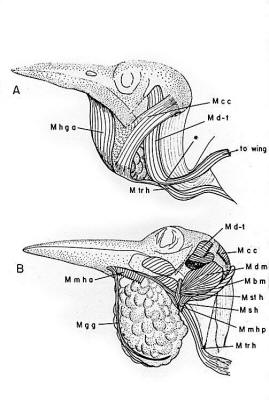 |
Figure 12. Sublingual pouch.
Muscle names in Bock et al., 1973.
|
Nutcrackers have long, pointed wings for
strong flight. They often fill their sublingual pouches with pinyon
pine seed and the fly up to 22 km to a caching area (Vander Wall & Balda 1977, 1981). The also can carry seeds 1,900 m up the side of
the Peaks.
Nutcrackers can distinguish between
pinyon pine seeds that contain female gametophyte material (nut
meat) and those that are empty by observing the color of the hull or
shell. The other species of pines do not label their seeds.
Nutcrackers also use Bill clicking, the rapid opening and closing of
the mandibles, to help determine if the seed is full (Ligon & Martin, 1974) and also help determine the thickness of the seed coat
(Johnson et al., 1987). In an autumn when the pinyon pines have
masted, thousands of discarded cones occur on the ground containing
a large numbers of seeds with yellow hulls.
The daily sequence of events during the
autumn caching season proceeds as follows. Birds open seeds and
consume pine seeds at first light. Then seed collecting begins and
pouches are filled. Birds continue to harvest seeds for the entire
day traveling 5-7 times from harvest area to caching area and back.
Seeds are cached in the substrate at
depths of 2-3 cm. (Figure 13) These caches are
totally concealed
from view as birds often place soil, litter, pine needles, pine
cones and even small stones on top of the hidden seeds. These
objects seldom remain in place for long due to wind, water, and
gravity. Most likely these objects are placed on top of the cache to
conceal the soil disturbance made by creating caches, not to
conspicuously mark the location of the cache.
|
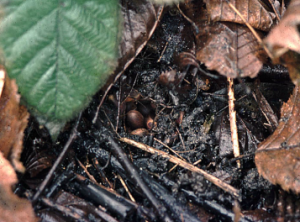 |
Figure 13. Exposed pine seed cache.
|
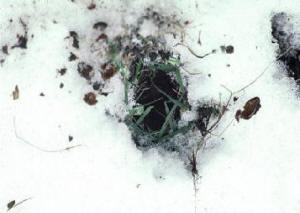
Figure 14. Cache site where nutcracker has recovered
cache through snow.
| |
Caches are created in a wide variety of sites, including
meadows, tundra, open woodlands, closed canopy forest, rocky
outcrops, thick needle layers, cinders, and bare soil. Many of these
sites experience low amounts of snowfall or early snow melt thus
allowing birds' ready access to their caches. Often nutcrackers
cache seeds at sites used by numerous other nutcrackers for caching.
However, even though the site may be communal the caches are not, as
birds can only locate the caches they have created (Vander Wall,
1982; Vander Wall & Balda, 1977).
Nutcrackers often proceed to cache in
two stages. First, when seeds are plentiful birds will extract them
and cache them near the harvest tree. Second, after the cones have
been depleted these caches are recovered and the seeds transported
some distance and then recached (Tomback, 1998) The former may
be a technique to get as many seeds as possible out of the
conspicuous cones and into hidden sites, the locations of which are
known only to the cacher. Later seeds may be moved to more
protected sites or sites with fewer seed predators present.
In a year with a heavy cone crop a single nutcracker can
cache between 22,000 and 33,000 seeds in over 7,000 individual cache
sites (Vander Wall & Balda, 1977). Birds may place between one and
14 seeds per cache. Birds continue caching until the crop is
depleted or snow covers the caching areas (Vander Wall & Balda, 1977). Possibly, birds curtail caching after snow
remains on the ground because to cache in these conditions would
reveal cache location by their foot prints left in the snow.
Seed caches may be harvested
immediately after the harvest is finished. Often, birds eat the
recovered seeds directly at the site of recovery, thus providing a
measure of recovery accuracy. Most workers report that nutcrackers
recover seeds from about 80% of their probe holes (Tomback, 1980; Turek & Kelso,
1968). This estimate must be low as some seeds
recovered from caches are carried off before consumption, and some
sites must be pilfered by cache robbers. This high estimate is a
truly a tribute to the spatial memory ability of the Clark's
nutcracker when one considers: 1) nutcrackers spend less than 30
sec. making a cache (Kamil et al., 1999); 2) they make thousands of
caches each autumn; 3) they returned to
accurately recover their caches many months after creating them; 4)
they recover through a substrate that has been greatly altered
between the time of caching and recovery. This means that caches
created under one set of substrate characteristics are recovered
under a very different set of substrate characteristics. For
example, caches made in the fall
before snow is present are recovered through snow (Figure 14).
Caches made when green vegetation is present are recovered after
this vegetation has died and disintegrated. This suggests that these
local cues or landmarks are not used by the birds as the sole
source of information about the location of their caches.
Nutcrackers are heavily dependent on
their cached seeds for survival in winter and as food for their
offspring. Giuntoli and Mewaldt (1978) found that between 80 and
100% of the winter diet of nutcrackers was made up of conifer seeds,
most likely recovered from caches. Other foods are consumed, when
present, as the nutcracker becomes a feeding generalist during
warmer weather. Clark's nutcrackers are among the
earliest nesting species of North American birds initiating nesting
at high elevations in the San Francisco Peaks in February or early
March (Tomback, 1998). Early breeding may occur because of having
stored enough food to provide the energy and nutrients for this
early reproductive effort. To withstand the cold temperatures,
nutcrackers build large, sturdy, well insulated nests. Both males
and females have brood patches and can thus share in the duties of
incubating eggs and brooding nestlings. This also allows each member
of the pair to go off, individually, to locate its own pine seed
caches. The diet of nestling nutcrackers is almost exclusively
conifer seeds (Bendire, 1889; Johnson, 1900; Mewaldt, 1956). This is
a highly unusual food for nestling birds and requires a major
adaptive change in the digestive physiological of the birds to
produce specific digestive enzymes to digest these seeds. After
fledging, young birds follow their parents to caching areas where
they are also fed pine seeds. This event normally occurs 9-11 months
after the seeds have been stored (Vander Wall & Hutchins, 1983).
In late spring and early summer adult
nutcrackers are often seen far from their normal haunts. These birds
fly slowly just above the tips of trees. We suspect these birds are
assessing the location and size of the cone crop that will be
harvested in the coming months (RPB, pers. obs.). In years when cone crops fail
nutcrackers leave their high mountain haunts and fly long
distances in search of alternate foods. These irruptions take birds
hundreds of km from their normal range (Vander Wall et al., 1981;
Westcott, 1964). Thus, nutcrackers are highly specialized
in morphology, physiology, and behavior for the extraction,
transport, caching and recovery of conifer seeds and these
specializations form a suite of adaptations that extend into all
aspects of the bird's life history.
2. Pinyon Jay. (Figure 15)
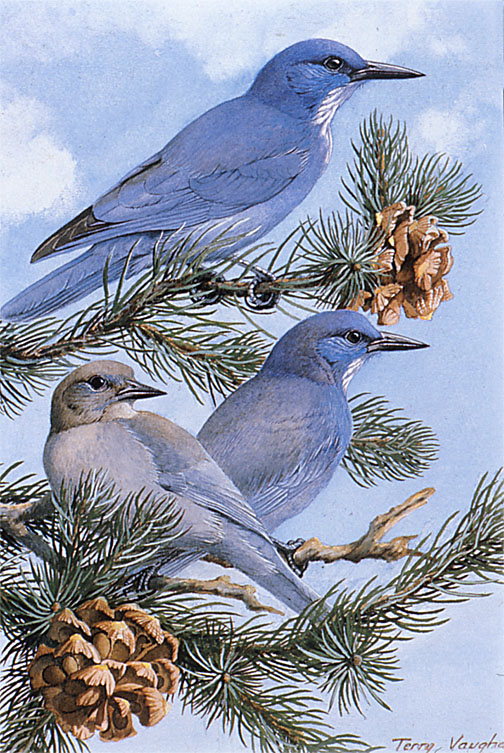 |
Figure 15. Adult male (above), adult female (middle), and juvenile (lower)Pinyon pine with cones.
|
This species, as its name implies, is closely linked to the pinyon pine which lives that the base of the San Francisco Peaks.
In the San Francisco Peaks, however, these jays interact with most species
of pines across all Life Zones. They nest in the pinyon-juniper
woodland and ponderosa pine zones, where seeds are readily cached.
In fall, they also roam far above these zones in search of seeds.
Pinyon jays possess a number of adaptations for
harvesting, transporting, caching and recovering seeds. They have a
relatively long, sharp bill that is featherless at its base.
Consequently, the bird's nostrils are exposed and can be a source of
heat loss under cold conditions. However, the loss of these feathers
means that the featherless length of the bill is effectively
lengthened, an adaptation especially useful for extracting seeds
from pitch laden pine cones. The trade-off must be in favor of the
longer, feather-free bill compared to the amount of heat potentially
lost. The sharp bill is used to hack open closed pine cones and also
the hulls of pine seeds, thrust seeds into the soil, and probe into
the soil to recover hidden seeds. A special articulation of the jaw
allows birds to absorb the bill's impact during strong pounding
(Zusi, 1987).
Seeds are held during transport in an expandable esophagus which
when full, can hold about 40 seeds. This amounts to about 12%
of its body weight (Vander Wall & Balda, 1981). Pinyon jays can distinguish between empty and full pinyon pine
seeds using the color of the seed coat. Pinyon pine seeds are also
"Bill Weighed" and "Bill Clicked" as done by nutcrackers (see above)
(Ligon & Martin, 1974). Cones can be opened on the tree branch or broken off and carried
and wedged tightly into a forked branch. When wedged in a fork, the
bird can grip the surrounding branches tightly with both feet and
forcibly hammer the cone open. Shredded cones commonly
accumulate under such sites.
Cone opening, seed harvesting, pouching, transporting, and
caching seeds is a flocking event. These behaviors are performed by
all members of the flock in synchrony. These flocks have
permanently mated pairs, stable membership, contain extended family
units, and remain on permanently delineated home ranges. Pine seeds are transported to
traditional caching areas that
are used year-after-year. Flocks have between 8 -10 of these traditional caching areas on their home ranges. These
"traditional" areas are often located where the substrate is loosely
packed, contains patches of exposed soil, rocks, and cinders, and
has a shallow litter layer. These characteristics indicate a well
drained soil (Balda, 1987, 2002). Flocks move in synchronous fashion from harvest to caching area
and can make between 5-9 round trips per day from harvesting to
caching areas depending on density of the cones, and distance from
the caching areas. Flocks may fly up to 11 km, on long strong wings,
between harvest and caching areas
Pinyon jays seem to favor specific microhabitats as cache
sites. They appear to prefer to cache near objects, including the
base of cliffs, large boulders and especially tree trunks, often on
the south side. These southern exposures are first to melt free of
snow or accumulate less snow following a winter storm (Balda &
Bateman, 1971, 1972). Jays however, have been observed digging
through a layer of snow 5 cm deep to recover caches. Pinyon jays use sites other than the substrate for caching.
Stotz and Balda (1995) found that 86% of 114 above ground cache
sites were crevices in tree bark. Other sites include in rock piles,
grass tuffs, and pine nettle clusters high in trees..
Caches are created as the flock walks slowly and silently over
the substrate. Birds continuously thrust their bill into the soil
and litter as they deposit one or more seeds per site (Stotz & Balda, 1995). A single bird can make a dozen caches in less than a
minute. Generally, flock members move in a particular
direction during caching but individual birds may move in any
direction. Pinyon jays normally place a single seed in a cache but
on occasion they may place up to seven seeds per cache. At
times, however, birds will thrust their bills into the substrate but
not deposit a seed. This if often referred to as false caching
(Balda, 2002) and may be a technique used to confuse potential intra-
and inter-specific cache pilferers. In a year when cone crops are dense, a single bird can cache up
to 26,000 seeds in up to 20,000 individual sites (Marzluff & Balda,
1992). Ligon (1978) estimated that a flock of 250 birds in New
Mexico could collectively cache 4.5 million seeds in a single autumn
when cone crops are heavy.
Although caches are made synchronously by the flock, field
observations (Balda & Bateman, 1969, 1971) suggest that birds
accurately recover their own caches. This is especially interesting
for pinyon jays because they: 1) cache within the structure of the
flock which means birds move in unison over the terrain when
creating caches, so individuals have little control over the general
area where they can cache; 2) have little time for individual
decisions about where to make specific caches because the flock is
always on the move; 3) make caches in rapid succession resembling
the needle of a sewing machine; 4) must be concerned with pilfering.
Young-of-the-year pinyon jays and adult Steller's jays often
watch intently as flock members are caching and then attempt to
locate their caches when they move on. Most attempts appear to fail,
but sometimes the bird that has created the cache will respond by
either chasing the potential pilferer away or digging up the cache
and moving it to a new location (RPB pers. obs.). Mated pairs of pinyon jays appear to coordinate their movements
during caching so that they can observe the creation of each others
caches (Chen, 2000; Shulzitski, 1999). These findings come solely from
laboratory studies. It is difficult to follow individual birds in a
flock because of the sheer numbers and continual movement, thus
these observations have not been confirmed for pairs in the wild.
Pinyon jays nest in late winter and early spring when cone crops
are large. Nests are large and well insulated, and often constructed
on the south side of the tree (Balda & Bateman, 1972). The
female is the sole incubator of the eggs as only she possesses a
brood patch. Males must feed their females during the incubation and
early brooding phase of nesting because of low temperatures. Adult
jays rely heavily on pine seeds in winter when they may constitute
between 70 and 90 percent of the diet (Ligon, 1978). At this time,
seeds are no longer present in cones so these seeds must come from
caches created by the birds. Males must procure and deliver these
seeds to the nesting female. Young pinyon jays are also feed pine
seeds as a portion of their diet. Bateman and Balda (1972) found
that pine seeds comprised 11% of the nestling's diet while Ligon
(1978) found pine seeds made up 32% of the diet. As mentioned
for nutcrackers, the ability of nestlings to digest plant material
is a rare adaptation in song birds, requiring major changes in the
digestive enzymes possessed by the birds. Juvenile birds first began caching when 3 weeks post-fledging.
For the first 9 weeks of caching young birds cached primarily
non-food items such as rotten pinyon and ponderosa pine seeds,
flakes of tree bark, rabbit scat, dead insects, and a roofing nail.
After 12 weeks of age jay began caching edible pine seeds (Stotz & Balda, 1995)
In years when pinyon pine cone crops are low, pinyon jays cache
seeds of the other pines, many of which have large wings. Birds are
efficient at removing the wing by holding the seed in there mouth
with the wing protruding directly outward and then knocking the wing
off on a branch or other object. This behavior differs from that of
the nutcracker which appears to simply bite off the wing (RPB, pers.
obs.) No detailed studies are available of the use of these
pines by pinyon jays. However, Balda and Bateman (1971) report that
pinyon jays are highly industrious in the harvest and caching of
ponderosa pine seeds. When there is a general failure of the pines to produce cones
pinyon jays may irrupt from their normal range and emigrate hundreds
of km in search of food (Westcott, 1964). These irruptions may
consist of huge numbers of birds or small bands of birds that scour
the country side for food (RPB pers. obs.).
3. Steller's Jays. (Figure 16)
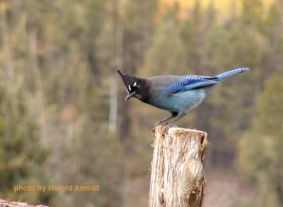 |
Figure 16 Steller's Jay.
|
This species is a permanent
resident of the coniferous forest zones on the San Francisco Peaks.
It readily caches ponderosa and pinyon pine seeds in autumns when
cone crops are available. Steller's jays also cache acorns of local
oaks. This jay does not have a strong, sharply pointed bill
for opening green cones and thus must wait for cones to open before
it can extract seeds. It does have an expandable esophagus, for
about one-third of its length that can hold up to 20 seeds during
transport. Birds can carry seeds about 5 km (Vander
Wall & Balda, 1981) from pinyon pine trees in the woodland
and cache them in the ponderosa pine forest. This jay appears to
cache in small family units or pairs. Steller's jays appear highly
motivated to harvest and cache seeds. A single bird may make 5-7
trips with seeds per day between woodland and ponderosa pine forest.
Thus, at this intensity one bird can cache about 7,800 seeds per
autumn.
When pinyon pine seeds are placed on a feeder
Steller's jays are quick to collect these seeds in their expandable
esophagus (RPB pers. obs.). Few studies have been done on their
relationship to pine seeds and acorns (Abbot, 1929;
Christensen & Whitham, 1991; Vander
Wall & Balda, 1981). At a feeding station where inedible (hollow) seeds were dyed
dark brown to make them look edible, these jays carried them off.
Steller's jays have never been seen to test the quality of seeds by
bill-clicking or bill weighing so it is possible they cannot
discriminate seeds as well as the above two species (Vander Wall & Balda,
1981). Steller's jays may be efficient cache robbers on
nutcrackers and pinyon jays, (Burnell & Tomback, 1985). When a
flock of pinyon jays comes through areas inhabited by Steller's jays
they sit silently in trees observing where pinyon jays are creating
caches.
Little is know about the caching and recovery behavior of
Steller's jays even though they share habitats with humans and
readily come to feeders and picnic tables to collect and carry off
seeds (Brown, 1994). In a year of heavy cone production Steller's
jays were observed to cache 46% of the time in soil, 22% of the time
in bark crevices, 18% of the time in rock and stump crevices, and in
ponderosa pine needle clusters 15%. Most often one seed is placed
per cache. (Vander Wall & Balda, 1981). Around dwellings birds will
cache under litter in gardens, in lawns, in tree crevices, in storm
gutters, under roofing shingles, in depressions and cracks in wood
siding and decks, and in cracks in sidewalks (RPB pers. obs.).
Steller's jays probably use their cached food solely for winter
survival as there are no reports of them feeding cached seeds or
acorns to nestlings. Possible all cached food is consumed before
nesting is initiated. No observations have been reported on the
accuracy of recovery of stored food in the wild. Observations near
homes would suggest the jay is quite accurate when recovering cached
food (RPB pers. obs.). Steller's jays nest in late April and early May. Thus, they show
no tendency for unusually early nesting and do not build
bulky, well insulated nests.
This bird has not been studied under closely controlled
laboratory conditions because it is extremely difficult to hold in
cages and aviaries (RPB pers. obs.). Consequently little is known
about its spatial memory abilities. However, the amount of food
stored, the presence of an expandable esophagus, and the amount of
time birds spend caching would suggest that the bird is readily able
to find the seeds it caches. This species does not nest in late winter, does not build a
large nest and does not feed its young pine seeds. Also, it does not
usually undergo huge irruptions when cone crops fail. Thus, many of
the Steller's jay's life history traits are not affected by the
presence or absence of pine seeds.
4. Mexican Jays (Figure 17) and Western Scrub Jays.
(Figure 18)
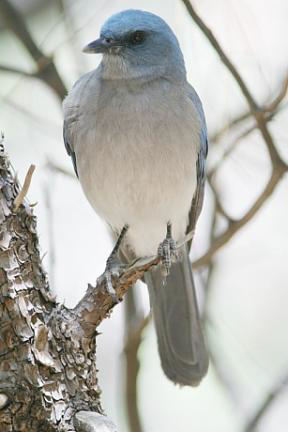 |
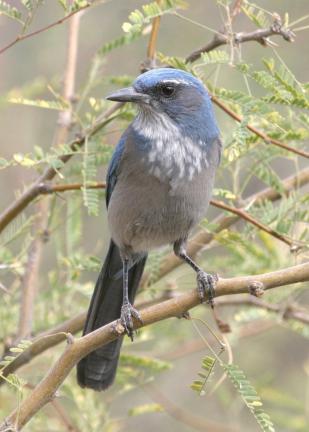 |
Figure 17. Photograph of Mexican Jay by
Ralph Shant.
|
Figure 18.
Photograph of Western Scrub Jay by D. Von Gausig.
|
These two species (Figures 17,
18), closely related congeners, are
permanent resident species in the pinyon-juniper woodland on and
at the base of the San Francisco Peaks. Both species harvest and
cache pinyon pine seeds from open cones. The western scrub-jay
is the most common species in the woodland habitat and may
maintain permanent, year round territories occupied by a single
pair of birds. The Mexican jay is highly social with 5-25 birds
occupying permanent territories (Brown, 1994). Neither
species posses any specialized structures for the collecting,
transporting, caching or recovery of pine seeds. Scrub jay
bills, for example are relatively short (x = 19.6 mm, n = 20),
rather blunt, and therefore relatively poorly adapted for
opening green cones (Balda, 1987).Scrub jays that cache pinyon
pine seeds have slightly more pointed, but rather thin bills,
used for extracting seeds from open pine cones, holding the
seeds during transport and thrusting seeds into the substrate
(Peterson, 1993).
Neither species is able to open green
cones and must wait for cones to ripen. Scrub jays have been
observed silently watching nutcrackers and pinyon jays opening green
cones then flying rapidly at them while vocalizing loudly. The
startled birds drop the partly opened cones and fly up into the
trees. Scrub jays proceed to retrieve the cone and extract the
exposed seeds (Vander Wall & Balda, 1981). These jays have no specialized
structure for carry seeds from tree to cache site except in mouth
and bill. Consequently they can only carry 3-5 seeds per trip. These
jays do not have strong long wings, but relatively short rounded
ones. They usually carry pinyon pine seeds no more than 500 m to 1
km. Scrub jays do possess the buttress complex which makes the lower
mandible effective for pounding open hard shelled seeds (Zusi,
1987).
Both species may be able to distinguish
good (dark brown hulled) seeds from empty (yellow hulled) seeds but
they are not known to bill click or bill weigh seeds. Both species usually cache one seed per
cache and make repeated caches within one m of each other. Cache
sites are primarily along edges of trees and stumps and under dense
foliage. Of 62 observed caches made by scrub jays, 29 were under
pinyon pine trees, 8 were under junipers, 8 were near a bush, 3 were
near logs, and 14 were out in open meadows (Hall & Balda,
unpublished MS). The majority of caches placed under trees were
south of the trunk. These observations indicate that scrub jays have
a set of preferred caching sites that are frequently used.
Scrub jays and Mexican jays nest in late
April and early May, showing no tendency to nest earlier when cone
crops are heavy. Neither species builds a large well insulated nest,
nor is known to feed pine seeds to its nestlings. These two species are the most general
feeders in the group and although they store pine seeds in autumn
they are not as motivated as the nutcracker, pinyon and Steller's
jay. Scrub jays store about 6,000 seeds in an autumn when the cone
crop is large. They do not spend every waking moment harvesting,
transporting and caching pine seeds. If the did so they could easily
double the number of seeds cached (Balda, 1987). This is so because
they transport seeds relatively short distances compared to the
other species, and have many more snow-free days to cache. These two jays do not undergo major
eruptive movements when cone crops fail. This may be an indication
that these species are not as heavily dependent on cached food as
the nutcracker and pinyon jay.
The corvids of the San Francisco Peak region show an ecological,
morphological and behavioral gradient in their adaptations for the
harvest, transport, and storage of pine seeds. Ecologically,
species living in the harshest environments where winter
productivity is nil are most dependent on cached seeds during
winter, whereas species living where winter is milder are less
dependent on cached seeds. Morphological features that show this
pattern include bill size and shape (Figure 19), the structures used
to carry seeds, and variation in wing length and shape for
long, flights. Behaviorally, the number of seeds that can be
transported is highly correlated with the distance they are carried
(Figure 20), and the presence of a specialized structure for doing
so. The Clark's nutcracker and pinyon jay, the two species living at
the highest elevations, cache huge numbers of seeds compared to the
two jays that inhabit the lower, warmer woodlands. Of the five
species discussed above only nestling nutcrackers and pinyon jays
are equipped to digest pinyon pine seeds. The scrub jay and
Mexican jay do not show the same levels of intensity to harvest
seeds as is shown by the nutcracker and pinyon jay.
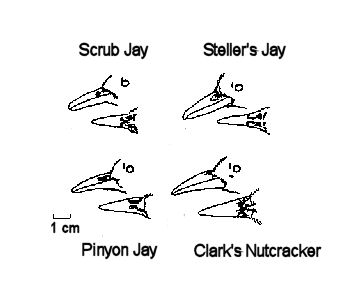 |
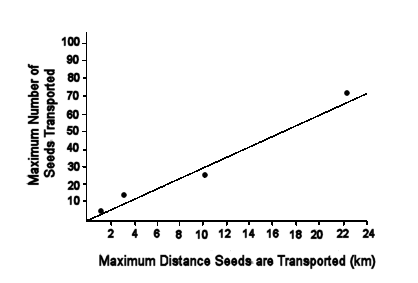 |
Figure 19. Bill sizes and shapes of four seed caching corvids.
|
Figure 20. The relationship of distance seeds are transported and average
number of seeds carried. Nutcracker is far right, Western Scrub
jay far left, Steller's jay, second from left with pinyon jay in
the middle.
|
There can be no doubt that these birds
have an adaptive suite of characteristics for the harvest,
transport, and caching of seeds. The components of this adaptive
suite vary depending on the selective forces present in the Life
Zones each species inhabits, and the life history strategy employed
by each species. The four species show a clear specialization
gradient from more highly specialized species, to more generalist
species.
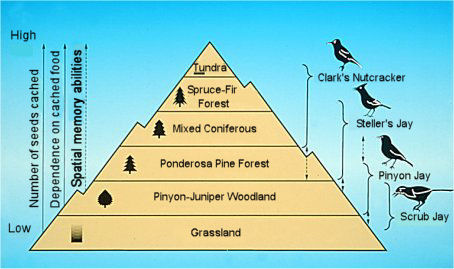 |
Figure 21. Distribution of four species on San Francisco Peaks. The
hypothesis is listed on the left side.
|
The phenomenon we described above makes it clear that there is a
complex interaction of natural history and ecology on the one hand,
and behavior and physiology on the other. While these
phenomena strongly suggest that the ability to find stored food is
critical for the survival of these species, they do little to
explain how the different species manage to perform the
extraordinary task of relocating hidden seeds from thousands of
sites months after they were created. However, the pattern in
behavioral and physiological traits strongly suggests a similar
pattern may exist in certain cognitive traits. This led us
(Balda & Kamil 1989; Kamil & Balda, 1990) to propose the
following hypothesis: Species that are
most dependent on cached seeds for survival in winter and early
spring when no other foods are available will have better spatial
memory abilities than those species that are less dependent on
stored food for winter survival.
More specifically, we predicted that Clark's nutcrackers and
pinyon jays have spatial memory abilities that are superior to those
of scrub jays and Mexican jays (Figure 21). Findings to
support this hypothesis will strongly support the suggestion that
spatial memory ability is another trait in the adaptive arsenal
employed by species to enhance their fitness.
Although field observations suggest an accurate spatial memory in seed cachers,
these observations are incomplete because simply observing the act of
recovering a cache is inconclusive. The observer does not know the
identity of the recovering bird, what bird made the cache, how long the cache
was present, if the seeds were visually apparent to the bird, if the soil was
disturbed in such a manner to suggest that a cache of seeds was present at this
location, etc. Also, most birds are highly secretive when creating caches and
avoid making caches when being observed. Pinyon jays are an exception, but they
cache at such a rapid rate it is almost impossible to keep track of their cache
sites. They also create false caches which makes finding their caches very
difficult. Consequently, in order to study the accuracy of spatial memory for
finding cached seeds, it was necessary to develop laboratory techniques that
could control or hold constant many potentially intervening variables. Below we
will describe our methods in detail.
When using controlled laboratory experiments to explore species differences in
mental capabilities there are many potential problems. Species may respond
differently to the experimental apparatus, or to the stimuli used to elicit a
response. Also, some species may simply be able to adjust to captivity or to
the experimental manipulations better than others. In addition, some species
may simply be better test takers than others. In our attempt to overcome these
potential problems we employed three different experimental paradigms, in a
process referred to as converging operations (Kamil, 1988). If the pattern of
results across species remains consistent over these three different tests, we
can then be more confident of the reality of these species differences than we
could on the basis of a single task.
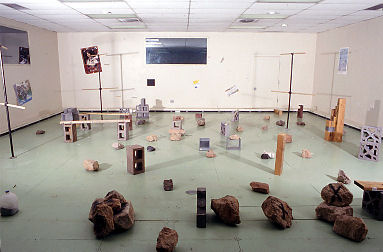 |
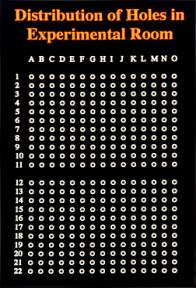
|
Figure 22.
Photograph of large experimental room. Note objects on
the floor and wall.
|
Figure 23. Distribution of holes
in experimental room.
|
In order to directly
test for accuracy of spatial memory when recovering caches we
conducted a series of experiments in large free-flying, experimental
rooms. These rooms contained raised floors with holes at regularly
spaced distances (Figure 22, 23). Each hole was 5.5 cm in diameter
and could be filled with a sand-filled cup for caching or a wooden
plug to prevent caching. These rooms contained many landmarks,
posters on the wall, observations windows, a porthole through which
the bird entered and exit the room, a door, and a centrally located
feeder. Because the experimental rooms were designed to
enhance the internal validity (Kamil, 1988) of our experiments there
was a question if the birds would cache in the sand-filled cups
(Figure 24).
|
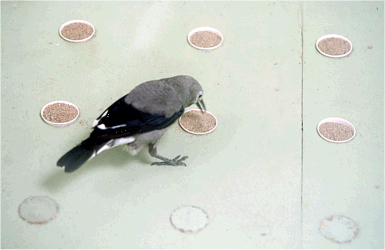
|
Figure 24.
Clark's nutcracker caching in a sand filled cup.
|
Birds were captured
from the wild and tested in numerous experiments. Birds were of
unknown age and sex. Nutcrackers, pinyon
jays and Mexican Jays were housed individually in 0.51 x 0.51 x 0.72
m metal cages. All birds were held on a 10:14 hr light:dark cycle.
They were fed a daily diet of pigeon pellets, meal worms (Tenebrio
larva), sunflower seeds, turkey starter, cracked corn, and a vitamin
supplement. They had constant access to ground oyster shell and
fresh water. Between experiments birds were also fed a ration of
pinyon pine seeds. During experiments, however, these seeds were
withheld and used as the experimental stimuli. Before each caching
and recovery session, birds were deprived of all food for 24 hr.
Scrub jays, because of their smaller size were housed in smaller
cages but all other conditions were the same as described.
During experiments birds were allowed to enter the experimental
room directly from their cages through a porthole in the wall.
Before entering the room the cages were darkened and the
experimental room was illuminated. Birds thus flew into the lighted
room. After a session was completed the lights in the room were
extinguished and the cage illuminated. The birds then left the
experimental room and flew directly through the porthole into
their cages. Thus, birds were not handled before, during or after an
experiment. For caching sessions a predetermined number of holes
were opened and were filled with sand in a predetermined pattern. A
feeder was placed in the center of the room and contained a
predetermined number of pinyon pine seeds. For recovery sessions all
signs of digging in the sand-filled holes was swept up from the
floor, one seed was placed into cups where caches had been made, and
the feeder was empty. There were no signs of digging or presence of
seeds in the cups that the birds could have used as cues to locate
caches.
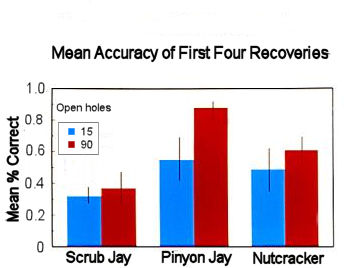 |
Figure 25. Mean accuracy for three species of seed caching birds in the
15 and 90 hole conditions of the experiment.
|
 |
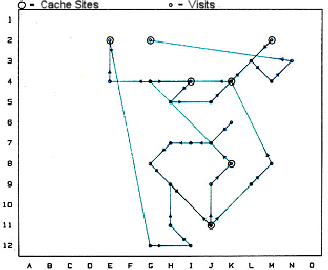 |
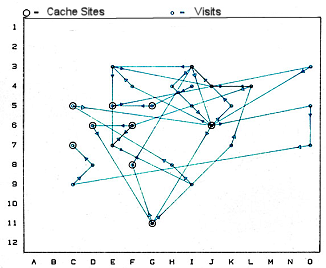 |
Figures 26, 27, 28. Diagram of
the distribution of cache sites used by a pinyon jay, a
nutcracker, and a western scrub jay in the 90 hole condition.
|
This test of spatial memory was conducted in a 3.4 x 3.4 m
experimental room with 180 holes in the raised floor. The accuracy
of recovery was tested under two conditions. In one condition 90
holes were available for caching and in the other condition only 15
holes were opened for caching. The rationale for this two stage
design was to assess the accuracy of the three species after they
the birds were given free choice of cache placement so that a
placement strategy could have been employed (90 hole condition).
This accuracy can then be compared to that achieved after severely
limiting the number of available cache sites (15 hole condition).
Under this condition a cache site placement strategy would be
severely inhibited. Seven days after making caches birds were
allowed back into the experimental room to recover their caches.
Accuracy was assessed as the proportion of holes probed that
contained a seed.
In most of the recovery trials birds preformed better than
chance (40 out of 42) and all three species performed better in the
90 hole condition than they did in the 15 hole condition.
Nutcrackers and pinyon jays were significantly more accurate than
scrub jays in both conditions (Figure 25). There was no significant
difference between nutcrackers and pinyon jays in recovery accuracy.
Pinyon jays appeared to be most affected by the 15 vs. 90 hole
condition. During the 90 hole condition they placed their caches in
conspicuous clumps. The average distance between caches was 0.81 m
for pinyon jays, 1.22 m for nutcrackers and 1.5 m for scrub jays.
These results support our hypothesis that recovery accuracy is a
function of the ecology and natural history of the species being
investigated. Nutcrackers and pinyon jays which have morphological,
and physiological adaptations for this behavior and are also most
dependent on their cached seeds for winter survival and
reproduction, performed significantly better than scrub jays. However, pinyon jays could have used a nonmnemonic technique
such as area restricted search to find their caches. If caches are
placed in all available cups in a cluster then birds need to only
search in this small restricted area. The clumping of caches may be
a result of the social nature of pinyon jays as they cache as a
social unit (Figure 26, 27, 28).
Because of this, they may be prone
to place caches close together as their movements may be restricted
by the presence of other group members. In nature pinyon jays appear
to place caches close to one another (RPB pers. obs.). In a follow up experiment (Romonchuk, 1995) allowed nutcrackers
and pinyon jays to create 25 caches in 330 sand filled cups in the
floor of a large experimental room (9.1 x 15.3 x 2.8m) The mean intercache distance was measured by averaging the intercache
distances between all possible unique pairs of caches. Mean
intercache distance was significantly closer for pinyon jays (mean =
2.66 m) than for nutcracker (x = 3.86). These results corroborate
the findings of the first experiment.
This experiment set out to test if
pinyon jay cache recovery accuracy was dependent on placing caches
close together so an area restricted search pattern can be used
rather than employing spatial memory. This was a follow up to A1.
The experiment was conducted in the
large room in which the floor contained 330 holes. This experiment
used two unique sets of holes chosen from the 330 holes available.
In one condition, 72 evenly spaced holes were opened and in the
other 36 evenly spaced holes were opened. Birds were allowed to make
15 caches. In the former condition the jays could clump caches but
the in the latter condition clumping should have been prevented.
If birds use area restricted search to locate caches than accuracy
should be higher during recovery in the 72-hole condition than in
the 36 hole condition. Mean intercache distances were not
significantly different between the two conditions but was smaller
for the 72-hole condition (mean = 3.62) than for the 36-hole
condition (mean = 4.01). However, both of these distances are much
greater than the distances found by Balda and Kamil (1989) and
described above for all three species.
Accuracy was measured using a single
cache recovery attempt procedure (SCRAP) developed by Kamil and
Balda (1990). During recovery sessions caches were presented to the
bird as a series of clusters. Each cluster consisted of four holes
arranged in a square. The cache was one of the holes in this square.
The other three holes had not been cached in. The number of probes
that were used to find a cache within a cluster could vary from zero
(found cache on first probe) to three (found cache on fourth probe
after probing the three none-caching holes. If a bird was probing at
random the mean number of errors would be 1.5. For each cluster
containing a cache site another cluster was opened but did not
contain a cache site. Thus, during recovery birds had a choice of
which cluster to visit (those with a cache site imbedded and those
without cache sites) and which hole to probe within a cluster (hole
with seeds or hole without seed).
Pinyon jays performed impressively under
both conditions making about 0.75 errors per cluster. There was no
significant difference in accuracy between the two conditions. Birds
also visited good clusters significantly sooner than they visited
bad clusters. This experiment provides strong evidence that it is
not necessary for pinyon jays to place their caches in clumps and
then use area restricted search to find them. Pinyon jays have
precise spatial memories for the location of their caches.
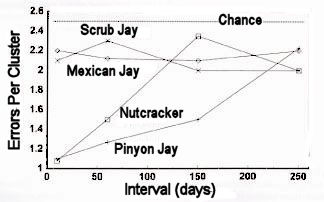 |
Figure 29. Mean errors per cluster for the four species of corvids at
retention intervals of 50, 100,
150, 200 and 250 days.
|
Above we have shown that nutcrackers and pinyon jays have better
spatial memory than scrub jays. These finding however, are for
relatively short durations. In fact, much shorter than those
expected in nature (based on the natural history observations
presented earlier). In this experiment we asked if the duration of
memory for cache sites varied among the four species. Earlier
research (Balda & Kamil, 1992) indicated that Clark's nutcrackers
accurately remembered the location of caches sites for up to 285
days. Here we tested nutcrackers, pinyon jays, Mexican jays and
scrub jays for recovery accuracy at 10, 60, 150,and 250 days after
caching. The SCRAP procedure (describe above) with cache sites
imbedded in a cluster of 6 open holes in a 2 x 3 rectangle was used.
Chance performance would thus be 2.5 errors per recovery.
Nutcrackers and pinyon jays were highly accurate at the 10 and 60
day interval but only modestly accurate at intervals of 150 and 250
days. The scrub jays and Mexican jays performed at above chance
levels at all intervals but were generally less accurate than the
former species. (Figure 29). A species by interval ANOVA of
the mean number of errors, showed that nutcrackers and pinyon jays did not
differ significantly from each other, and the scrub and Mexican jay did not differ significantly from each other, but the
two groups differed significantly. Thus, these results support the
hypothesis that species most dependent on their caches to survive
the winter and for reproduction have more accurate spatial memory
than species less dependent on their caches.
Although the comparative tests of spatial memory reveal that the species more
dependent on their caches for survival and reproduction than less dependent
species, these differences might be due to the effects of contextual variable
that could result in this consistent pattern of species differences. As
mentioned above, one or more species might be better suited for this type of
research paradigm than other species. Also, is this spatial memory gradient
limited to cache recovery or can this ability be generalized to other tests of
spatial memory? To address these potential problems, we conducted a series of
spatial memory experiments using procedures other than direct tests of cache
recovery (Kamil, 1988).
|
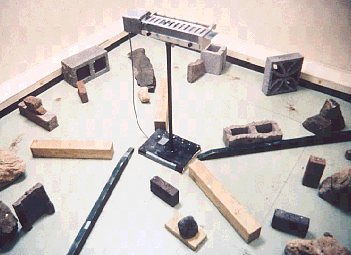 |
Figure 30. Photograph of radial arm experimental room.
|
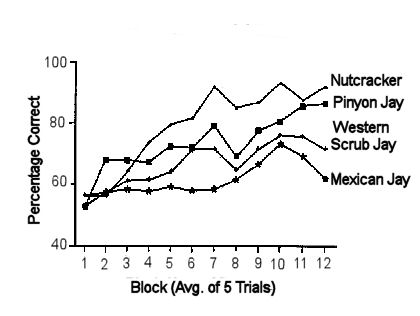 |
Figure 31. Comparative Radial
Maze. Performance of the four species of seed caching corvids during acquisition of the radial maze experiment.
|
This experiment was carried out in a
small room (3.6 x 3.2m) where birds could fly free as they searched
for seeds. The raised floor contained 12 holes arranged in a circle
(Figure 30). Numerous objects were present on the floor and
posters were hung on the walls. Birds entered and exited the room through a porthole in the
wall. Members of each species were habituated to the room and
learned to dig for seeds in holes that were filled with sand. After
habituation birds were given 60 acquisition trials. Each trial
consisted of three parts, a pre-retention stage, a retention
interval, and a post retention stage. During the pre-retention stage
the room contained four randomly selected open holes. Each hole
contained a carefully buried seed. The bird entered the room and
proceeded to harvest and eat the seeds. This stage continued until
the bird found and ate the four food rewards. The bird then departed
the room and the retention interval started. During the retention
interval the room was swept clean of all signs of digging, and four
additional holes were opened and a seed buried in each. After the
five minute retention interval the bird was allowed
back into the room. The room now contained eight open holes, the
four original holes that the bird had previously emptied and the
four newly opened holes. Only the newly opened holes contained
seeds. During the post-retention stage the bird remained in the room
until it located the four food rewards or it made six probes. For
each bird to perform accurately it had to remember the four holes it
had visited during the pre-retention stage, avoid them, and visit the
newly opened holes. A different set of randomly selected holes were
used daily. Trials were run six days per week. During the 60
acquisition trials, all four species initially had similar levels of
performance, but they rapidly diverged (Figure 31). Nutcrackers and pinyon jays learned the task faster and performed more accurately
than the western and Mexican jay.
These results compliment our earlier
findings about dependence and spatial memory. They also show
that spatial memory is general and not simply a specialization for
finding hidden food caches made by an individual. What other
tasks these species with highly accurate and robust spatial memory
can perform is unknown at the present time. However, the
possibilities are numerous and potentially exciting.
Test of spatial memory in an operant
chamber strips away most all environmental influences from the
organisms taking the test, and allows exacting control of the
subject and the stimuli. Thus, this task allows us to enhance and
maximize the intrinsic validity of the experiment (Kamil, 1988). For
example, birds are rewarded when they peck at the correct spot when
illuminated. This is a huge difference from pecking at a spot in the
ground where a cache has been previously created.
Olson (1991) found that nutcrackers out
performed western scrub jays in this type of task. The present
experiment was designed to extend those findings and also to
determine if the species differences we had observed in other tasks
were also present in nonspatial tasks. In the nonspatial task, birds were
asked if they could remember a color in order to receive a food
reward. The experiment was conducted in an operant chamber with a
computer monitor at one end and a pecking key and feeder at the
other. Trials were initiated when an illuminated spot appeared in
the middle of the monitor. The spot was either red or green, chosen
randomly for each trial. When the bird pecked this spot, the screen
became clear. Now, a yellow light was illuminated behind the key.
The bird now was required to go to the rear of the chamber and
pecked the yellow light causing it to extinguish. At this time two
lights were illuminated on the monitor, one red and one green. Now,
when two pecks were delivered to either color, the trial was ended.
A trial was considered correct, and a food reward given, if the bird
choice the new color. The bird was required to remember what color
it had seen and pecked during the initial part of the trial and then
avoid that color and peck the alternate color during the final stage
of the trial. This type of test is known as a non-matching to sample
test.
After the birds learned to perform this
test we wanted to determine how long the birds could remember the
color presented during the first portion of the trial. To do this we
introduced a titration procedure. A retention interval was added
between the first peck at the illuminated color on the monitor and
the final choice test. This retention interval increased when the
bird made a correct choice and decreased when the bird made an
incorrect response. A correct response caused the retention interval
to increase by 0.1 seconds and an incorrect response caused the
retention interval to decline by 0.2 seconds.
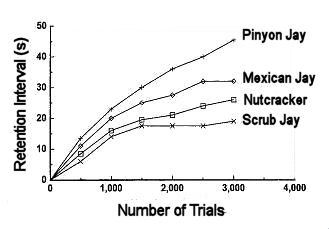 |
Figure 32. Performance of each species during color memory nonmatching-to-sample titration.
|
The results of this experiment were
unambiguous and did NOT correlate with our earlier findings. Species
most dependent on cached food did not perform more accurately than
species less dependent on hidden food. None of the species
differences were statistically significant (Figure 32).
However, the speed of acquisition and retention interval did appear to be correlated withsocial organization. The best performance was
by pinyon jays and Mexican jays. Both species live in permanent
social groups. The worst performance was by nutcrackers and scrub
jays that have a more solitary life style. Sociality may require
certain types of cognitive abilities not found in non-social species
(Balda et al., 1996).
Immediately after the above experiment
was finished we placed these same birds into another, almost
identical test. This time, however, they were tested for spatial
memory rather than for color memory. All details of the experiment
remained the same, however, when the monitor was first illuminated
one of two locations, chosen at random, lit up. Then during the
choice phase of the test two identical spots were illuminated. One
of the spots was at the exact location on the monitor where the
initial spot had appeared. The second spot occurred at a new
location. Again employing the non-matching to sample paradigm,
the novel location was the correct one. This time very different
results emerged. Clark's nutcrackers were far superior to the three
species of jays, thus duplicating the findings of Olson for
nutcrackers and scrub jays. These findings are consistent with the
results from radial maze and cache recovery tests. It is, however,
the first test to demonstrate a difference between nutcrackers and
pinyon jays as the latter specie's performance could not be
separated from that of the scrub and Mexican jay.
The results of these tests are
particularly important as they allow us to rule out some alternative
explanations for the species differences we found in spatial memory
tests. We can eliminate explanations such as general intelligence or
general adaptability or compatibility to laboratory experimental
procedures. If any of the above factors were involved, then we
should have found the same rank order of species differences in the
non-matching to sample color test as we found in spatial tests. We
did not.
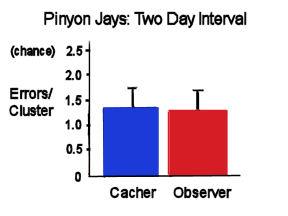 |
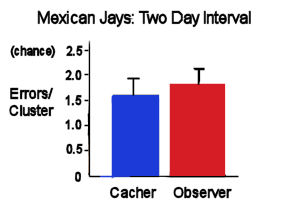 |
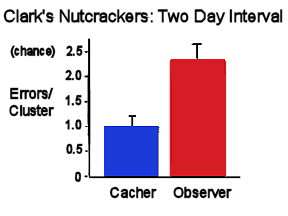 |
Figures 33, 34, 35. Accuracy of
caching and observing pinyon jays, Mexican jays, and Clark's
nutcrackers when recovering caches. Observer is recovering
caches made by the cacher.
|
In the wild, pinyon jays and Mexican
jays live in integrated flocks and may cache together as a unit each
fall when pine cones ripen. In contrast, Clark's nutcrackers cache
either as single individuals, pairs, or small family groups. We
asked if the three seed caching species had the ability to locate
caches made by conspecifics. We hypothesized that species
differences may occur that reflect their social life style. If so
then pinyon jays and Mexican jays should be able to locate caches
made by flock members but nutcrackers should not.
To test this hypothesis we used a small
caching room (3.7 x 3.4 m) with 237 holes in a raised floor. Twenty
holes contained a sand-filled cups were available for caching. A
bowl with 70 pinyon pine seeds was placed on the floor. One caged
bird was placed on a 1 m high platform in the center of the room. A
second bird was allowed into the room to cache in the 20 holes.
After caches were created both birds were removed from the room for
24 hrs. During this time all signs of digging were swept up and one
seed was placed into each cache site. Cachers and observers were now
allowed to individually recover caches in the room. Pinyon jay and Mexican jay observers
were just as accurate as their respective cachers (Figures 33,
34, 35). Nutcracker observers, however, were not accurate at
locating caches made by the cachers, even though the cachers
themselves were the most accurate of the three species when locating
caches they had made (Figure 38). These results support our
hypothesis that social species may have the ability to locate caches
made by conspecifics and therefore must take special precautions
when creating caches to avoid being detected.
These findings also raised some
interesting mechanistic issues. This experiment demonstrates that
neither traveling to a specific cache site nor creating a particular
cache are necessary for locating that cache. These findings also
show that pinyon jays and Mexican jays are not simply matching the
view from the cache site during caching because they never cached at
these sites. Also, birds did not follow a particular route to the
cache site. If so, they would have landed on the platform where
their cage was originally located and then preceded to the cache
site. These results suggest that the evolution of caching behavior
may have been different for social and nonsocial species and
suggests a number of studies with other caching species, i.e. the
relatively nonsocial western scrub jays and the closely related but
social Florida scrub jays.
Clearly, the ability of Clark's
nutcrackers (and other seed-caching birds) to relocate their
cache sites is remarkable, and based on spatial memory. But
this raises a very interesting question: When a nutcracker is
searching for stored pine seeds, exactly how does it recognize that
a particular location is a cache site? That is, exactly what
is it about that location that the nutcracker has encoded and
remembered? This question is particularly compelling given the
precision with which they return to a specific location that has no
marker or beacon, sometimes even digging through snow to find seeds
(Crocq, 1978). Nutcracker caches are often located in the
middle of open meadows with few local features (Tomback, 1977, 1980;
Vander Wall & Balda, 1981). There are landmarks (henceforth
abbreviated "LMs"), but many of them are distant from the cache
sites, and there is usually no surface feature identifying the cache
site within the surrounding terrain. Yet the nutcracker
lands on the spot and digs up seeds that it buried months ago.
Its bill is a relatively small shovel, requiring it to dig within a
few centimeters of the buried seeds, which are themselves quite
small. Indeed, Bednekoff and Balda (1997) demonstrated that
nutcrackers are extremely accurate when they use response topography
of vertical head movements, with little side-to-side motion, for
digging.
Although these characteristics of cache
recovery imply that nutcrackers navigate with exceptional accuracy,
little is known about how the task is accomplished, except that it
is based on the location of LMs. Balda (1980), Vander
Wall (1982), and Balda and Turek (1984) showed that if LMs are either
removed or shifted between caching and recovery, accuracy of seed
recovery deteriorates markedly, to chance levels in some cases.
This suggests that the geometry of the relationships among LMs and
cache positions might affect search behavior.
Kamil, Balda, and Good (1999) analyzed
videotapes of caching and recovery to try to understand how
movements during caching were related to those during cache
recovery. Among caching behaviors quantified were time spent
and number of probes at individual sites and the compass direction
used to approach and leave the site. There was no evidence
that any of these measures correlated with recovery accuracy.
Especially important in its implications for LM use, birds recovered
caches very quickly and accurately when approaching or probing the
cache site from a completely different direction than that used
during caching. Consistency of direction of approach was
completely unrelated to recovery accuracy. Because the birds'
view of the LMs in the room varies with the direction of movement,
this suggests that, as implied by Basil (1993), multiple
relationships between goal locations and LM arrays were being used.
We then began a series of studies using
what has been called the transformational design (Cheng & Spetch,
1998), a powerful technique for investigating LM use.
Animals are first trained to find a hidden goal (such as a buried
piece of food) located at a fixed place relative to an array of LMs.
During training, the LM array is presented in different locations
(but with constant relationships among the LMs within the array) to
ensure that the LM array is the only feature that accurately
predicts goal location. Once the animal has learned to find
the goal, occasional trials are conducted with the goal absent and
the LM array transformed in some way. Response to the
transformation is used to infer how the LM array is being used.
Gould-Beierle and Kamil (1996) examined
how nutcrackers integrated information when a landmark was located
near an edge. Like the pigeons and black-capped chickadees studied
by Cheng and Sherry (1992), nutcrackers responded more to shifts in LM
position that were parallel to the edge than to shifts perpendicular
to the edge. In two subsequent studies (Gould-Beierle & Kamil,
1998, 1999) , we found that global cues had more control over search
when local cues were further from the goal. This
extends previous work suggesting that cues close to a goal location
can exercise more control over search than LMs further away (e.g.,
Cheng et al., 1987; Morris, 1981; Spetch, 1995).
The transformational approach has been
applied to the question of how many LMs are remembered. A
location of an object in space can usually be defined in multiple
ways. For example, consider a cache site located in a meadow
within 6 m of three big rocks. The cache location could be
defined in terms of its distance and direction from any one of the
rocks, or in terms of its directional relationship to any two of the
rocks, or its distance from one rock and direction from another,
etc. Thus, it is logically possible to use only a single
LM to define and remember a goal location. And the phenomenon
known as overshadowing suggests that this may be the case, at least
under certain circumstances.
In a typical overshadowing experiment,
animals are trained to find a goal whose position is defined by a
set of LMs whose distance from the goal varies, and are the tested
during occasional probe trials with only a single LM present.
The accuracy of search during the probe trials. Several
studies with pigeons have found that search is most accurate when
the LM present during the probe trial is that LM that was located
closest to the goal during training (Cheng, 1988; Spetch,1995).
However, these experiments employed landmarks that were very close
to the goal location and the results may not generalize to the use
of more distant landmarks. Furthermore, the results of several
studies with nutcrackers indicate that these birds remember the
spatial relationships amongst multiple LMs and a goal location.
For example, Vander Wall (1982)
had nutcrackers cache seeds in a large outdoor aviary. Then,
during recovery sessions, LMs in one part of the aviary were shifted
20 cm east, with seeds remaining in their original locations.
In the area in which LMs were shifted, the birds' search was also
shifted east by 20 cm. But on the edge of that area, where
some LMs had been shifted and others had not, search was
intermediate between the shifted and nonshifted locations. The
birds must have been averaging information from different LMs.
In another instance, Basil (1993) used
nutcrackers with a technique similar to Bennett (1993) with European
jays. Birds were trained to find a goal location defined by a
LM array that was presented in many different locations and
orientations within the test room. LMs in the array varied in
size and distance from the goal. Probe trials with some LMs
removed showed that large, close LMs were more important than
smaller ones further away from the goal, as in Bennett (1993).
However, Basil conducted a more extensive set of probe tests than
Bennett (1993), obtaining clear evidence that the nutcrackers
learned multiple rules for locating the goal. Basil had 9 LMs
in her array, and tested for ability to find the goal with various
sets of 3 LMs each. Although the birds performed better with
some arrays than others, they could find the goal regardless of
which set of three LMs was present. Clearly, they had learned
more than one small set of the available goal-LM relationships.
(This result was different from that of Bennett, who found that only
the two tall LMs nearest the goal controlled search. This may
be a species difference but is more likely due to Bennett's placing
these LMs only 30 cm from the goal, producing an overshadowing'
effect (Spetch, 1995). Basil used distances of 40-60cm.)
A recent study by Goodyear and Kamil
(2004) examined overshadowing and the effects of goal-LM distance in
nutcrackers. Three groups of Clark's nutcrackers were
trained to find a goal location defined by a landmark array.
Each group was trained with an array of four LMs, with the goal
located in the midst of the array. The different groups were
trained with arrays that varied in the goal-LM distances (Figure
36).
|
|
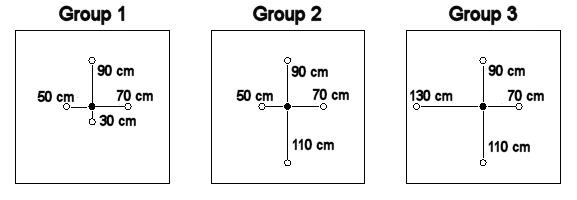 |
|
Figure 36. Diagram of landmark array for the three
experimental groups of Goodyear and Kamil (2004). Gray circles represent landmarks while black
circles represent the goal location. Goal-landmark
distances are labeled for each landmark. Lines are not
drawn to scale.
|
These goal-LM distances were chosen so
that the effects of both relative and absolute goal-landmark
distance could be assessed. All three groups readily learned
the task and were subsequently tested in probe tests with only
single landmarks from the array available. Search error in
tests with landmarks the same distance away from the goal was
compared across groups where only the relative position of the
landmarks varied. When the LM array was located relatively
close to the goal, overshadowing occurred, and only that LM closest
to the goal resulted in accurate search. As the goal-LM
distance of the array increased, however, this effect diminished.
Thus the results of this study indicate that multiple LMs are more
likely to be simultaneously encoded when goal-LM distances are
relatively great.
|
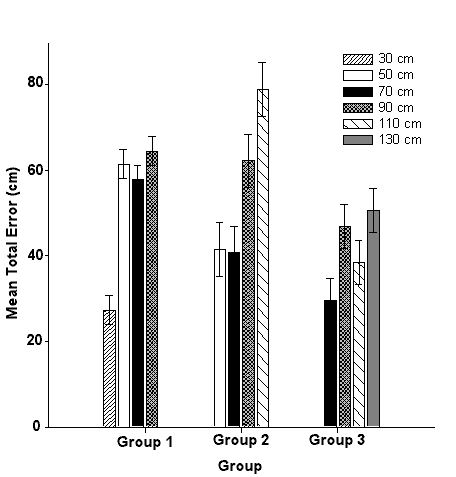 |
Figure 37. Mean total error in single landmark tests for each group. Error
bars represent standard error.
|
The next step in the development of our
thinking about the use of LMs during cache recovery was provided by
a study by Kamil and Jones (1997) that suggest that directional
evidence is emphasized when the goal-LM distance is relatively
great. Nutcrackers were trained to dig for a seed hidden
halfway between two LMs. Five interLM training distances were
used. The birds readily learned the task, generalizing to new
distances interpolated between training distances. Detailed
analysis of the distribution of search behavior showed the birds
were very accurate with both the interLM distances with which they
were trained and the new interLM distances (Figure 37).
The nutcrackers appeared to have learned
a general principle, although the exact nature of that principle
remained to be specified. These results have been extended in
several additional studies. Kamil and Jones (2000) showed that the
birds could learn and generalize geometric rules other than halfway,
while Jones and Kamil (2001) found that the birds could learn the
geometry of arrays that were rotated during training. However,
the most important result regarding the general use of LMs was an
unanticipated feature of the data from the halfway learning
experiment. Error in judging distance from a LM increased more
rapidly than error in judging direction as goal-LM distance
increased.
Because the birds had been trained to
find a goal that was located on the line connecting the two LMs, it
was possible to measure distance error and direction error
separately. Simply put, error in the axis of the line from
goal to LM reflects error in the estimation of the distance to the
LM while error in the axis perpendicular to that line reflects error
in the judgment of direction from goal to LM. Furthermore, as
the axes are perpendicular, the estimates are independent. We
have repeatedly found that the functions relating search error to
goal-LM distance are ions relating search error to goal-LM distance
are very different for distance and direction estimation (Kamil &
Jones, 1997, 2000). The problem of locating a point on a line
has two components: locating the LM-LM line and finding the correct
position along it. These are problems in direction and
distance estimation, respectively. When the search error of
birds trained to find a point on the LM-LM line was partitioned into
the two appropriate axes, we have always found that error in each
axis increases as goal-LM distance increases, but with much steeper
slope in the distance than the direction axis (Figure 38). This
suggests that when the LMs that control search are far from the
goal, information about the direction from goal to LM will produce
more accurate search than information about the distance from the
goal to the LM.
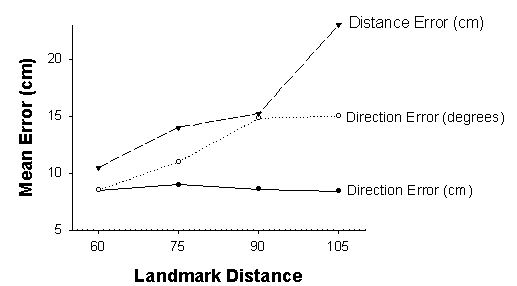 |
|
|
Figure 38. As the distance between the landmarks increased from 60 to 105 cm, distance and direction error both increased, but the rate of increase was greater for distance error.
However, when the direction error was calculated in degrees, it
did not change as interlandmark distance increased.
|
This conclusion raises the question of
how search accuracy can be achieved in the face of error in the
compass used for the estimation of direction. The task of
locating a buried seed calls for a high degree of accuracy. A
compass with an error of measurement of 1% will induce an error of
"6.3 cm in search location when the goal is 1 m from the LM (and an
additional "6.3 cm for each additional meter of goal-LM distance).
Kamil and Cheng (2001) suggested that the use of multiple LMs
provides a powerful way to reduce the effects of error in
directional estimation and achieve precise search. If the
direction from the goal to each of a number of different LMs is the
primary information in the representation of the goal location,
these multiple bearings can be used to overcome inaccuracies caused
by compass errors.
Suppose a goal location has been encoded
in terms of n bearings, one to each of n different LMs. What
happens to search accuracy as n increases, given error in the
compass used to determine bearings? The information provided
by increases in n can decrease search error. Consider n = 2.
In most cases (it depends on the angular separation of LMs) there
will be two intersecting bearings. However, if there is
compass error, the point of intersection will not be at the goal and
there will be no information available about size or direction of
the error. Now consider n = 3. In many cases, the three
bearings will describe a triangle, whose size will contain
information about magnitude of the compass error.
Kamil and Cheng (2001) investigated this
issue with a Monte Carlo simulation in which the compass measurement
of bearing to each LM was given a random error of "2%. Search
accuracy decreased significantly as n, the number of LMs encoded,
increased. In fact, search error was reduced by 35% by
increasing the number of LMs being used from two to four.
There can be little doubt that increasing the number of LMs
represented in directionally based encoding can dramatically
increase search accuracy.
Based on these empirical results and
their simulation, Kamil and Cheng (2001) proposed the
multiple-bearings hypothesis: goal locations that are relatively far
from LMs will be remembered in terms of the directional bearings
from the goal to each of several LMs. This hypothesis makes
many specific predictions. Search accuracy should increase as
the number of available LMs increases, which was confirmed by Kamil,
Cheng, and Goodyear (2001), and should be sensitive to the detailed
geometrical relationships among the available LMs and the goal.
As of this writing, several studies are underway testing predictions
of the model in Clark's nutcrackers.
Evidence from several experiments
suggests that when caching in the field, nutcrackers, pinyon jays
and scrub jays do use a compass based on the sun as one of their
sources of directional information. It is well known that migratory
birds use a number of different compasses, including the sun
compass, to find their way during migration (Wiltschko & Wiltschko,
1998), and this ability may also be present in non-migratory seed
caching birds.
Wiltschko and Balda (1989), Balda and Wiltschko (1991), and Wiltschko, Balda, Jahnel,
and Wiltschko (1999)
studied the role of the sun compass in Clark's nutcrackers, pinyon
jays and scrub jays in a series of cache recovery experiments.
An octagonal outdoor aviary with a diameter of 4.90 m served as the
experimental chamber. The floor of the aviary was divided into eight
pie-shaped segments, each containing six holes that could be filled
with a sand-filled cup for caching or a wooden plug that prevented
caching. This aviary was placed within a courtyard surrounded by
four high buildings of different heights and shapes, each having a
unique set of window and door patterns.
Birds were habituated to this aviary and
then allowed to create between one and four caches in 12 holes
contained in two adjacent segments of the floor. These two segments
are referred to as the caching sectors and were varied among birds
and tests. After caching, birds were removed from the aviary and
placed in their home cage in a light-tight holding room. For
all recovery sessions all 48 holes were opened and one seed was
placed into each cup the birds had cached in. The experiments were
performed in the following manner:
1. Control 1: Each bird was allowed to recover the seeds it had
cached 4-7 days earlier. The location of all probes in this control
served as a reference for comparison with the manipulated sessions.
2. Six hour slow clock shift. After caching each bird was
returned to its home cage and its internal clock was reset 6 hrs.
slow. Now the artificial photoperiod began and ended six hours
after normal sunrise and sunset. Birds were confined for at least
five days under these conditions. That is, if the sun normally rose
at six a.m., then the lights in the room would go on at 12 o'clock
noon. If sunset was a 6 p.m., then the lights in the room would go
off at midnight. On the first sunny day after the birds had
experienced the shifted condition for five days, the birds were
allowed to recover their caches. All 48 holes were now open and
filled with sand. A single seed was placed in the holes where the
bird had originally cached. In addition, a single seed was also
placed in the cups 90 degrees clockwise from the original set. If
the birds were using their sun compass, then these 90 degrees
clockwise locations would be the probed by the searching bird.
3. Re-shift to normal photoperiod. While birds were still in the
clock-shifted condition they were again allowed to cache in the
octagonal aviary. After caching, however, the internal clock of the
birds was shifted back to normal, which is a six-hour fast clock
shift. Now the light would go on and off at the time coinciding with
the normal outdoor light/dark cycle. Recoveries were conducted as in
#2 above with both original and shifted holes containing a seed.
4. Control 2. Same as in Control 1.
|
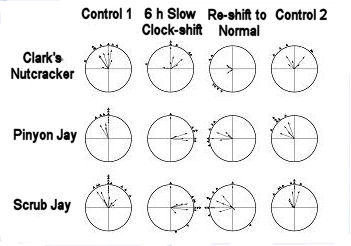 |
Figure 39. Distribution of Probing. Arrows representing the center of probing for
individual birds, with the mean heading of each bird indicated
by a triangle at the edge of the circle.
|
Figure 39 gives the vectors indicating the center of probing
activity when recovering caches for individual birds of the three
species. In Control 1, the majority of the vectors are pointed
toward the segment originally cached in. After the six hour clock
shift, the majority of the pinyon jays and scrub jays show the
clockwise deflection indicating that the sun compass is being
employed to relocate their caches. The Clark's nutcracker, however,
continued to mainly search in the original sectors. Under the
reshift condition all three species show expected counterclockwise
deflection. The rather short vectors for the nutcracker, however,
indicate a large amount of scatter. In Control 2, the pinyon jay and
scrub jay showed a tendency to probe left of the caching sector.
These experiments show that resetting
the internal clock influences the location where birds probe for
previously hidden seeds. This strongly suggests that compass
information is also involved, in some manner, in the spatial memory
system of these birds. These findings are especially of interest
because the courtyard where the aviary was located was rich with a
diverse set of landmarks.
Species difference in response to the
resetting of the internal clock were evident. Nutcrackers showed a
response in only the reshift condition, and that was weak.
Pinyon jays and scrub jays, on the other hand showed significant
responses to both shift and reshift manipulations. Thus, it appears
that the sun compass is a more important component of spatial memory
in these jays and is less important for nutcrackers. We can suggest
some possible reasons for this difference.
Nutcrackers live at high elevations
where the trees of the coniferous forests often form complete
canopies, impeding any sunlight from reaching the forest floor. In
spring, autumn and winter these high elevation habitats have many
cloudy, overcast, rainy days. Also, maybe the sun compass is not
effective when nutcrackers must dig through deep snow to recover
their caches. The pinyon and scrub jay live at lower
elevations where the canopy of the ponderosa pine forest and pinyon-juniper
woodlands are open as there are fewer trees present. Sunny
days are more prevalent at these lower elevations, and less snow is
present in winter, especially in the woodlands.
Therefore the general habitat structure
and prevailing weather conditions in the environments of the two jay
species may be more conducive for sun compass use. For the Clark's
nutcracker the sun compass may represent a factor not always
present, or easy to use, so they rely on other cues to locate their
caches.
|
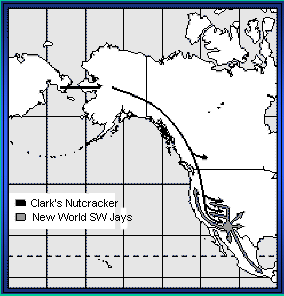 |
Figure 40. Colonization of North America by nutcrackers and
southwestern U.S. jays. Nutcrackers used the Bering Land Bridge
and jays differentiated on the Mexican Plateau.
|
We began this chapter with a description
of the environment within which these four species live, the San
Francisco Peaks in north central Arizona. How did this particular
set of species end up on this mountain?
The origins and dispersal patterns of
these species is well understood. The Clark's nutcracker is
undoubtedly of Old World origin, a close relative of the Eurasian
nutcracker (Nucifraga caryocatactes). It probably invaded the new
World by crossing the Bering Land Bridge about one million years ago
during the Pleistocene. It may even have carried a pouch full of
seeds across the strait (pers. communication,
Lanner, 1981; Stegmann, 1934; Tomback 1983)! The mountains of
Alaska, Canada, and western
North American were covered with alpine coniferous forest. This
habitat supplied the early invaders with the requisites needed for
survival and reproduction. The corridor stretched from Berangia to
central Arizona, allowing the nutcracker ease of passage from north
to south (Figure 40). Nutcrackers have strong, long wings for rapid, long
distance flights so latitudinal movements and flights up and down
mountains were probably swift and efficient.
The origin of the jays in this study
probably occurred on the Mexican Plateau located in the southwestern
USA and northern Mexico (Pitelka, 1951) The three species are closely
related (de los Monteros & Cracraft, 1997) These birds then
dispersed from their ancestral home and were possibly in their
present locations by the end of Pleistocene, about 11,000 years ago.
The difference in origin between the jays and the nutcracker brings
a whole series of issues to bear on the evolution of the seed
caching traits (Table 2).
|
Table 2. Convergence& Divergence Among Some Seed Caching Corvids |
| Character |
Pinyon jay and Nutcracker |
Western scrub-jay and Mexican jay |
| Seed Harvest and Transport |
| 1. Sturdy, sharp, bill |
Yes |
No |
| 2. Long, strong wings |
Yes |
No |
| 3. Structure for holding seeds |
Yes |
No |
| 4. Open green cones |
Yes |
No |
| 5. Cache huge numbers of seeds |
Yes |
No |
| 6.Rely on cached food |
Yes |
No |
|
Spatial Memory
|
| 1. Highly accurate in ache recovery |
Yes |
No |
| 2. Highly accurate in radial maze |
Yes |
No |
| 3. Highly accurate in operant test |
No-----------PJ--------> |
No |
|
Brain Structure
|
| 1. Large hippocampus |
No
----------PJ--------> |
No |
|
Nesting |
| 1.
Large, insulated nest |
Yes |
No |
| 2. Nest in winter |
Yes |
No |
| 3. Feed seeds to nestings |
Yes |
No |
| 4. Male has incubation patch |
No
---------PJ-------> |
No |
A reoccurring pattern in the results
from our various experiments was the specialization gradient whereas
species most dependent on their seed caches were most specialized in
morphology, behavior, physiology, and psychology, particularly in
spatial memory ability. In this specialization gradient Clark's
nutcrackers and pinyon jays demonstrated the most accurate spatial
memory, and the Mexican and western scrub jay showed only modest
spatial memory. The evidence reviewed above suggests that the
differences among scrub jays, Mexican jays and pinyon jays represent
divergence while the similarities between nutcracker and pinyon jays
represent a case of convergence. According to this view seed caching
behavior has evolved in the family Corvidae at least twice, once in
the Old World and once in the New World. The pinyon jay
appears to be a nutcracker "want-to-be."
The degree of convergence between
Clark's nutcrackers and pinyon jays is intriguing in terms of the
kinds of and degrees of adaptations. The three tables are designed
to show the different types of traits that show divergence and
convergence among the four seed caching species of corvids.
The cognitive abilities of the seed
caching species reveals some interesting patterns of
adaptations. The responds of the four species to the presence of
pinyon pine seeds differs dramatically. Two species show a major
integration of adaptations in all aspects of their lives, while two
other species show only modest adaptations for this habit. These
adaptations all build on one another. For example, the caching of
thousand of seeds would be wasteful if the cacher forgot the
locations of the caches, or placed them were other animals could
easily find them.
Of interest here is the fact that only
the nutcracker has a larger than expected hippocampus. The other
seed specialist, the pinyon jay does not (Basil et al., 1996). Thus,
either the hippocampus does extra duty or other areas of the
brain have been recruited to aid in the memory for seed caches in
the pinyon jay. However, new evidence suggests that hippocampus size
does not correlate with spatial memory ability.
Another example of the integration of
these adaptations is the life history trait of early breeding by
nutcrackers and pinyon jays in response to a large crop of pine
seeds. Breeding in February and March would be highly
ineffective if the breeders did not build large well insulated nest
to counter the cold weather, and effectively locate caches (even
through deep snow). The energy from these seeds provides the
reproductive energy to form eggs, provides heat for incubation and
brooding, and provides food for the nestlings. To utilize this food
nestlings must have the physiological ability to digest these pine
seeds. Many more examples of this integration could be given for
these seed caching species. In conclusion, cognitive abilities are
interlinked with all other characteristics of the species to form an
integrated adaptive suite of characters that contributes to the
biological fitness of the species possessing these suites.
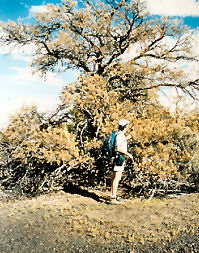
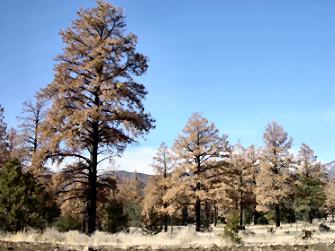 |
Figure 41. Dead pinyon pine that is at least 150 years old. |
Figure 42 (Right). Dead ponderosa
pines. One live pinyon pine in far left.
|
Trees
that are stressed because of low soil moisture are particularly
susceptible to infestation by bark beetles. Due to the combination
of moisture stress and beetle attack, hundreds of thousands
(possibly millions) of pinyon and ponderosa pine trees are dying on
our study area (Figure 41, 42).
Also, there has been no cone crop in
the past four years. This massive mortality event coupled with the
lack of pine cone production in trees that are still alive, posses a severe selective event
for all the resident birds and could have especially serious fitness
consequences for the seed caching corvids. One could predict, based
on the specialization gradient described above, that the nutcracker
and pinyon jays will be most heavily impacted and the western scrub
jay and Mexican jay would be affected to a lesser extent. This
situation is presently being monitored.
Abbot, H.G. (1962). The seed preferences of mice and voles in the
Northeast. Journal of Forestry, 60, 97-99.
Balda,
R.P. (1980). Recovery of cached seeds by a captive Nucifraga
caryocatactes. Zeitschrift fur Tierpsychologie, 52,
331-346.
Balda,
R.P. (1980). Are seed caching systems co-evolved? Acta XVII Congr.
International Ornithology. 2, 1185-1191.
Balda,
R.P. (1987). Avian impacts on pinyon-juniper woodlands. In L. Evertt
(Ed.) Proceedings of the pinyon-juniper conference (No. 7,
pp. 525-533). General Technical Report (INT-215). Reno, NV: U.S.
Forest Service.
Balda,
R.P. (2002). Pinyon jay (Gymnorhinus cyanocephalus).
In A. Poole, & F. Gill (Eds.), The birds of North America
(No. 605). Philadelphia, PA: The Birds of North America, Inc.
Balda,
R.P., & Bateman, G.C. (1971). Flocking and annual cycle of the
pinyon jay. Condor, 75, 287-302.
Balda,
R.P., & Bateman, G.C. (1972). The breeding biology of the pinyon
jay. Living Bird, 11, 5-42.
Balda, R.P., & Kamil, A.C. (1989). A comparative study of cache
recovery by three corvid species. Animal Behaviour, 38,
486-495.
Balda, R.P., & Kamil, A.C. (1992). Long-term spatial memory in
Clark's nutcracker, Nucifraga columbiana. Animal Behaviour 44,
761-769.
Balda,
R.P., & Kamil, A.C. (1998). The ecology and evolution of spatial
memory in corvids of the southwestern USA: The perplexing Pinyon
Jay. P. Balda, I.M. Pepperberg, & A.C. Kamil (Eds.), Animal
Cognition in Nature 7 (pp. 33-66). London, UK: Academic Press.
Balda,
R.P., Kamil, A.C., & Bednekoff, P.A. (1996). Predicting cognitive
capacity from natural history: Examples from four species of corvids.
In E. Ketterson & V. Nolan (Eds.), Current Ornithology
(pp.33-66). Plenum Press, New York.
Balda,
R.P., & Turek, R.J. (1984). The cache-recovery system as an example
of memory capabilities in Clark's nutcracker. In H. L.
Roitblat, T.G. Beaver, & H.S. Terrace (Eds.), Animal Cognition
(pp. 513-532). London, UK: Erlbaum Associates.
Balda,
R.P., & Wiltschko, W. (1991). Caching and recovery in scrub jays:
Transfer of sun-compass directions from shaded to sunny areas.
Condor, 93, 1020-1023.
Basil, J.A. (1993). Neuroanatomical and behavioral correlates of
spatial memory in Clark's nutcrackers. Unpublished PhD.
Dissertation, University of Massachusetts.
Basil, J.A., Kamil, A.C., Balda, R.P., & Fite, K.V. Differences in
hippocampus volume among food storing corvids. Brain, Behavior
and Evolution, 47, 156-164.
Bateman, G.C., & Balda, R.P. (1973). Growth, development, and food
habits of young pinyon jays. Auk, 90, 39-61.
Bednekoff, P.A., & Balda, R.P. (1996a). Social caching and
observational spatial memory in pinyon jays. Behaviour, 133,
807-826.
Bednekoff, P.A., & Balda, R.P. (1996b). Observational spatial memory
in Clark's nutcrackers and Mexican jays. Animal Behaviour, 52,
833-839.
Bednekoff, P.A., & Balda, R.P. (1997). Clark's nutcracker spatial
memory: Many errors might not be due to forgetting. Animal
Behaviour, 54, 691-698.
Bednekoff, P.A., Balda, R.P., Kamil, A.C., & Hile, A.L. (1997). Long
term spatial memory in four seed caching corvid species. Animal
Behaviour, 53, 335-341.
Bendire (1895). Life histories of North American birds. U.S.
National Museum Bulletin, 3.
Benkman, C.W., Balda, R.P., & Smith, C.C. (1984).Adaptations for
seed dispersal and the compromises due to seed predation in limber
pine. Ecology 65: 632-642.
Bennett, A.T.D. (1993). Spatial memory in a food storing corvid. I.
Near tall landmarks are primarily used. Journal of Comparative
Physiology A, 173, 193-207.
Bock,
W.J., Balda, R.P., & Vander Wall, S.B. (1973). Morphology of the
sublingual pouch and tongue musculature in Clark's nutcrackers.
Auk, 90, 491-519.
Brown, J.L. (1994). Mexican jay (Aphelocoma ultramarine). In
A. Poole, & F. Gill (Eds.), The birds of North America,
no.118. Academy of Natural Sciences, Philadelphia, PA, and American
Ornithologists' Union, Washington D. C.
Burnell, K.L., & Tomback, D.F. (1985). Steller's jays steal gray jay
caches: Field and laboratory observations. Auk, 102,
417-491.
Chen,
B. (2000). Differential spatial memory by male and female pinyon
jays. Unpublished M.S. thesis. Northern Arizona University,
Flagstaff.
Cheng, K. (1988). Some psychophysics of the
pigeon's use of landmarks. Journal of Comparative Physiology A.
162, 815-826.
Cheng, K., & Sherry, D. F. (1992). Landmark-based spatial memory in
birds (Parus atricapillus and Columbia livia): The use
of edges and distances to represent spatial positions. Journal of
Experimental Psychology: Animal Behavior Processes, 106,
331-341.
Cheng, K., & Spetch, M.L. (1998). Mechanisms of
landmarks use in mammals and birds. In S. D. Healy (Ed.), Spatial
representation in animals. Oxford: Oxford University Press.
Cheng, K., Collett, T.S., Pickhard, A., & Wehner, R. (1987). The use
of visual landmarks by honeybees: Bees weight landmarks according to
their distance from the goal. Journal of Comparative Physiology
A, 161, 469-475.
Christensen, K.M., & Whitham, T.G. (1993). Impact of insect
herbivores on competition between birds and mammals for pinyon pine
seeds. Ecology, 74, 2270-2278.
Crocq, C. (1978). Ecologie du Casse-noix (Nucifraga
caryocatactes L.) dans les Alpes Francaises du sud: Ses
relations avec L'Arolle (Pinus cembra L.). Unpublished PhD,
L'Univerite d'Aix-Marseille, Marseille, France.
Giuntoli, M., & Mewaldt, L.R. (1978). Stomach
contents of Clark's nutcrackers collected in western Montana.
Auk, 95, 595-598.
Goodyear, A.J., & Kamil, A.C. (2004). Clark's
nutcrackers (Nucifraga columbiana) and the effects of
goal‑landmark distance on overshadowing. Journal of Comparative
Psychology, 118, 258-264.
Gould-Beierle, K.L., & Kamil, A.C. (1996). The
use of local and global cues by Clark's nutcrackers, Nucifraga
columbiana. Animal Behaviour, 52, 519-528.
Gould-Beierle, K.L., & Kamil, A.C. (1998). Use of
landmarks in three species of food-storing corvids. Ethology, 104,
361-378.
Gould-Beierle, K.L., & Kamil, A.C. (1999). The
role of proximity in landmark use by Clark's nutcrackers. Animal
Behaviour, 58, 477-488.
Johnson, H.C. (1900). The breeding home of the
Clark's nutcracker. Condor, 2, 49-52.
Johnson, L.S., Marzluff, J.M., & Balda, R.P.
(1987). Handling of pinyon pine seeds by Clark's nutcracker.
Condor, 89, 117-125.
Jones, J.E., & Kamil, A.C. (2001). The use of
relative and absolute bearings by Clark's nutcrackers, Nucifraga
columbiana. Animal Learning & Behavior, 29, 120-132.
Kamil, A.C. (1988). A synthetic approach to the
study of animal intelligence. In D.W. Leger (Ed.), Nebraska
symposium on motivation: Comparative perspectives in modern
psychology (Vol. 35, pp. 230-257). Lincoln, Nebraska: University
of Nebraska Press.
Kamil, A.C., & Balda, R.P. (1990). Spatial memory
in seed caching corvids. In G.H. Bower (Ed.), The psychology of
learning and motivation (Vol. 26, pp. 1-25). New York: Academic
Press.
Kamil, A.C., & Cheng, K. (2001). Way-finding and
landmarks: The multiple-bearings hypothesis. Journal of
Experimental Biology, 204, 103-113.
Kamil, A.C., & Jones, J.E. (1997). Clark's
nutcrackers learn geometric relationships among landmarks.
Nature, 390, 276‑279.
Kamil, A.C., & Jones, J.E. (2000). Geometric rule
learning by Clark's nutcrackers (Nucifraga columbiana). Journal
of Experimental Psychology: Animal Behavior Processes, 26,
439-453.
Kamil, A.C., Goodyear, A.J., & Cheng, K.
(2001). The use of landmarks by Clark's nutcrackers: First tests of
a new model. Journal of Navigation, 54, 429-435.
Kamil, A.C., Balda, R.P., & Good, S.
(1999). Patterns of movement and orientation during caching and
recovery by Clark's nutcrackers (Nucifraga columbiana). Animal
Behaviour, 57, 1327-1335.
Kamil, A.C., Balda, R.P., & Olson, D.J. (1994).
Performance of four seed-caching corvid species in the radial maze
analog. Journal of Comparative Psychology, 108, 385-393.
Lanner, R.M. (1981).The pinyon pine: A natural
and cultural history. Reno, Nevada: University of Nevada Press.
Ligon, J.D. (1978). Reproductive interdependence on the pinyon jay
and pinyon pines. Ecological Monographs, 48, 111-126.
Ligon,
J.D., & Martin, D.J. (1974). Pinyon seeds assessment by the pinyon
jay, Gymnorhinus cyanocephalus. Animal Behaviour, 22,
421-429.
Marzluff, J.M., & Balda, R.P. (1992). The Pinyon jay: Behavioral
ecology of a colonial and cooperative corvid. London, U.K.: T. &
A.D. Poyser.
Merriam, C.H. (1890). Results of a biological survey of the San
Francisco Mountain region and desert of the Little Colorado,
Arizona. In North American Fauna (No.3, I-vii, pp.1-136).U.S.
Department of Agriculture.
de
los Monteros, A.E., & Cracraft, L. (1997). Intergeneric
relationships of the New World jays inferred from cytochrome b
gene sequences. Condor, 99, 490-502.
Morris, R.G.M. (1981). Spatial localisation does
not require the presence of local cues. Learning and Motivation,
12, 239-260.
Olson, D. J. (1991). Species differences in spatial memory among
Clark's nutcrackers, scrub jays, and pigeons. Journal of
Experimental Psychology: Animal Behavior Processes, 17, 363-376.
Olson, D. J., Kamil, A.C., Balda, R.P., & Nims, P.J. (1995).
Performance of four seed-caching corvid species in operant tests of
nonspatial and spatial memory. Journal of Comparative Psychology,
109, 173-181.
Peterson, A.T. (1993). Adaptive geographical variation in bill shape
of scrub jays (Aphelocoma coerulescens). American
Naturalist, 142, 508-527.
Pitelka, F.A. (1951). Speciation and ecologic distribution of
American jays of the genus Aphelocoma. University of
California Publications in Zoology, 50, 195-463.
Romonchuk, W.J. (1995). The role of memory in cache-recovery in
Clark's nutcrackers and pinyon jays. Unpublished PhD dissertation,
Northern Arizona University, Flagstaff, AZ.
Schopmeyer, C.S. (1974). Seeds of wood plants in the United States.
In Agriculture, Handbook (No. 540, pp. 196-197). Washington
D.C.: U.S.D.A. Forest Service.
Shulzitski, J. (1999). Sex differences in the spatial memory ability
of mated pinyon jays. Unpublished MS thesis, Northern Arizona
University, Flagstaff, AZ.
Spetch, M.L. (1995). Overshadowing in landmark learning:
Touch-screen studies with pigeons and humans. Journal of
Experimental Psychology: Animal Behavior Processes, 21, 166-181.
Stegmann, B.K. (1934). On the ontogeny of the nutcracker (Kedrovka)
(trans. L. Kelso). Dolk. Akad. Nauk. SSSR, 24,
267-269.
Stotz,
N.G., & Balda, R. P. (1995). Cache and recovery behavior of wild
pinyon jays in Northern Arizona. Southwest Naturalist, 40,
180-184.
Tomback, D. (1980). How nutcrackers find their seed stores.Condor,
82, 10-19.
Tomback, D. (1983). Nutcrackers and pines: Coevolution or
coadaptation? In M.H. Nitecki (Ed.), Coevolution (pp.
179-223). Chicago, IL: University of Chicago Press.
Tomback, D. (1998). Clark's Nutcracker (Nucifraga columbiana).
In A. Poole & F. Gill (Eds.), The birds of North America (No.
331). Philadelphia, PA: The Birds of North America, Inc.
Turcek, F.J., & Kelso, L. (1968). Ecological aspects of food
transportation and storage in the Corvidae. Communications in
Behavioral Biology, Part A, 1, 277-297.
Vander Wall, S.B. (1982). An experimental analysis of cache recovery
in Clark's nutcracker. Animal Behaviour 30, 84-94.
Vander Wall, S.B. (1990). Food hoarding in animals. Chicago,
IL: University of Chicago Press.
Vander Wall S.B., & Balda, R.P. (1977). Co-adaptation of the Clark's
nutcracker and pinyon pine for efficient seed harvest and dispersal.
Ecological Monographs, 47, 89-111.
Vander Wall, S.B., & Balda, R.P. (1981). Ecology and evolution of
food-storage behavior in conifer-seed-caching corvids.
Zeitschrift fur Tierpsychologie, 56, 217-242.
Vander Wall, S.B., & Hutchins, H.E. (1983). Dependence of Clark's
nutcrackers (Nucifraga columbiana) on conifer seeds during
the post-fledging period. Canadian Field-Naturalist, 97,
208-214.
Vander Wall, S.B., Hoffman, S.W., & Potts, W.K. (1981). Emigration
behavior of Clark's nutcrackers. Condor, 83, 162-170.
Westcott, P.W. (1964). Invasion of Clark's nutcrackers and pinyon
jays into southeastern Arizona. Condor, 66, 441.
Wiltschko, W., & Balda, R.P. (1989). Sun compass orientation in seed
caching scrub jays (Aphelocoma coerulescens). Journal of
Comparative Physiology, 164, 717-721.
Wiltschko, W., Balda, R.P., Jahnel, M., & Wiltschko, R. (1999). Sun
compass orientation in seed-caching corvids: Its role in spatial
memory. Animal Cognition, 2, 215-221.
Zusi,
R.L. (1987). A feeding adaptation of the jaw articulation in new
world jays (Corvidae). Auk, 104, 665-680.
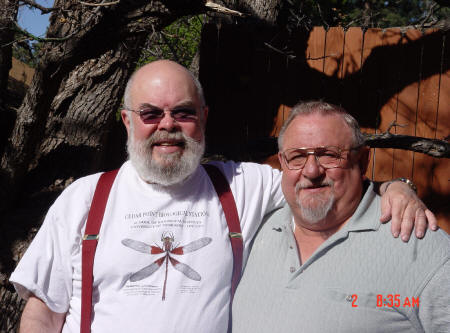
Acknowledgements
The findings presented in this chapter are the results of support
from the National Science Foundation and the National Institute of
Mental Health. We also thank our respective institutions for their
continuous support and encouragement during all phases of this
research. We are deeply indebted to the hundreds of students, both
graduate and undergraduates that participated in these studies
(obviously there are far too many to list). Without their help
this story could not be told. We must thank the four species
of seed caching corvids for their cooperation and willingness to
participate in these studies. One must see to believe what these
birds can accomplish! |
©2006 All
copyrights for the individual chapters are retained by the authors.
All other material in this book is copyrighted by the editor, unless
noted otherwise. If there has been an error with regards to
unacknowledged copyrighted material, please contact the editor
immediately so that this can be corrected. Permissions for using
material in this book should be sent to the editor.
|
|













































